Part 1 ~ The Journey Back to Otaru
The next day, which was a Saturday (18 December), we woke at around close to 9 a.m.. As we were to head back to Otaru later that day, we were relieved to have packed all our bags the night before. The landscape, as usual, was covered in snow, which made me grab some pictures.
At 9.30 a.m., we went down to Melt Bar & Grill to have our breakfast. At Melt Bar & Grill, we had a sumptuous and filling breakfast, including eggs. Even my brother liked the omelets, which he refers to as the Ratatouille omelette.
At 12 noon, we took our baggage and went down to the hotel lobby to check out of the hotel. My brother and I then waited in the hotel lobby lounge to wait. This is a picture of the hotel lobby.
At 12.40 p.m., my dad finally came up with our rented car. By 12.45 p.m., we were on board the car and were on our way back to the Grand Park Hotel Otaru.
15 minutes into the journey back to Otaru, we decided to stop over at JoJo's Cafe & Bar for a brief lunch break. Lunch was relatively light on that day for us.
After having lunch at JoJo's Cafe & Bar, we resumed our journey back to the Grand Park Hotel Otaru at 1.50 p.m.. The landscape was covered in snow throughout the journey, in spite of the fact that there was no snow storm.
At around 3.30 p.m. (2 hours 45 minutes into the journey), we decided to stop at the seaside cafeteria in Yoichi for some light bites and tea. The Sea of Japan was especially beautiful during the sunset, which made me grab some shots.
By 4.30 p.m., the sun was beginning to set, as it always does in the winter season. We then resumed our journey back to Otaru via the same road we took towards Niseko. The route again took us through the coastal route by the Sea of Japan. Again, the natural beauty of the Sea of Japan made me capture some beautiful shots.
As we neared the city of Otaru, we decided to stop by at Mount Tengu to see its winter and night appearance. The hill was really covered in snow, and used as a skiing area in winter. These are some pictures which I have taken before going up to Mount Tengu.
We went inside the ropeway station to get some round tickets to and from the mountain peak. After getting our tickets, we were on the Otaru Tenguyama cable car by 5.15 p.m.. Here are some pictures I took while on the way up to Mount Tengu.
At 5.20 p.m., we arrived at the Tenguyama Peak Station. As soon as we alighted the cable car, we immediately headed outside to see the beautiful scenery of the city lights at night.
There was also a mini-vehicle sliding slope at the peak of Mount Tengu. This is only open in the spring, summer, or autumn seasons.
After spending a few minutes in the open cold air outside the cable car station, we went to the Panorama Restaurant Tengu for a light dinner. I sat by the window which overlooked the city of Otaru. The views of Otaru were indeed spectacular, especially at night.
While at the Panorama Restaurant Tengu, I had a cup of hot chocolate and a mini Butadon set for dinner.
After spending some time at Mount Tengu Otaru, we decided to head to the Grand Park Hotel Otaru at 5.30 p.m.. We took the cable car down to the base station, and drove to the hotel.
After a journey time of almost 7 hours, we finally arrived at the Grand Park Hotel Otaru just before 7 o' clock in the evening. My mum then checked us in while I snapped a few pictures of the entrance hall.
After my mum checked us in, we were in our rooms by 7.15 p.m.. A few porters then came up with our baggage. With that, we had a light supper, and went to bed just before 1 o' clock that night.
Part 2 ~ The First Train Journey to New Chitose Airport
The next day, which was a Sunday (19 December), we woke up relatively late at around 11 o' clock that morning. From the very first moment I awoke, the views of the Sea of Japan from my room was spectacular. This made me snap a few images, after I had a shower and changed up to start the day.
At 12 noon, we got onto the car and drove to downtown Sapporo for lunch. The journey time between the Grand Park Hotel Otaru and downtown Sapporo. Here are some pictures that I can show to you if you like.
After we arrived at downtown Sapporo, the very first thing we did was to go the the JR Travel Service Center to Sapporo Station. We then exchanged my JR Hokkaido Rail Pass exchange voucher to a Hokkaido Rail Pass, for use on Limited Express trains for a free 4 days of my choice until 28 December.
At the Travel Service Center, I purchased my train ticket to New Chitose Airport. I was to be on the Rapid Airport train No. 152 bound for New Chitose Airport, which would depart from Sapporo Station at 3.25 p.m. (15 25). I was booked on a reserved seat ("u" seat), which cost me 1,340 yen (S$21.44).
As for the return journey to Otaru-chikko Station, I was booked on the Rapid Airport train No. 181 bound for Otaru, which would leave the airport at 6.04 p.m. (18 04). I was also booked on a reserved seat ("u" seat), which cost me 1,850 yen (S$29.60).
After I received my Hokkaido Rail Pass, I went up with my parents to a restaurant in the JR Tower Sapporo Station. As it was only 2.25 p.m., I still had an hour before my train to New Chitose Airport. I knew I had to be quick.
The clock was already close to striking 3 o' clock by the time I finished eating. Immediately, I went down to Sapporo Station. According to the departure information board, my train would depart Sapporo at 3.25 p.m. from Track No. 5. Here are some pictures which I took while waiting for the Rapid Airport train No. 152 for New Chitose Airport.
At 3.20 p.m., a 785 series EMU set, operating on the Rapid Airport train No. 152 bound for New Chitose Airport finally entered Sapporo Station on Track No. 5. The train had arrived from Asahikawa earlier as the Limited Express Super Kamui No. 26, and was to undergo a change of direction at Sapporo.
With that, I boarded the train, and settled into my assigned seat No. 2A for the 36-minute journey to New Chitose Airport.
At exactly 3.25 p.m., the Rapid Airport train No. 152 bound for New Chitose Airport, finally pulled out of Sapporo Station. With that, I was on my way for a 36-minute journey towards New Chitose Airport. Here are some pictures and videos which will explain the journey.
After a journey time of 36 minutes from Sapporo, I finally arrived at the New Chitose Airport terminal station at 4.01 p.m. (16 01), as planned. Before going up to the terminal building, I snapped some pictures on the platform.
After taking my usual pictures, I took the escalator up to the main terminal building. When I reached the terminal building, construction works were made on the top floor to make the connections to the international terminal easier.
I then headed to the Flyers hobby shop located on the third floor. According to the shop owner, they were temporarily located on the third floor due to renovation works on the top floor. The top floor, which would have a direct passageway to the international terminal, was due to open somewhere in 2011.
At Flyers, I purchased one plane model. The details are as follows:
1) Japan Airlines Boeing 747-446 "Oneworld" Hogan Wings Scale 1:500 (BJE2069)
At around 5 o' clock, I decided to head back to New Chitose Airport Station in preparation for my train journey back to Otaru. When I reached the station, the station man told me that it was still early before my train back to Otaru. However, I told him that I was alright waiting on the platform for 45 minutes. Here are some pictures I took while waiting for the Rapid Airport train No. 181 bound for Otaru, which would later depart at 6.04 p.m. (18 04).
After approximately 45 minutes of waiting, a 6-car 721 series EMU operating on the Rapid Airport train No. 170 from Otaru finally arrived at 5.46 p.m. on Track No. 1. The train would soon become the Rapid Airport train No. 181 bound for Otaru, which would leave the airport at 6.04 p.m. (18 04).
As soon as the train was cleaned, I immediately boarded the train at 5.50 p.m., and settled into my assigned seat No. 10D. The journey to Otaru-chikko would take approximately 1 hour 06 minutes. Here are some pictures I took while waiting for a 6.04 p.m. departure.
After all the passengers for the train were on board, we finally pulled out of New Chitose Airport Station at 6.04 p.m., as planned. I was then on my 1 hour 05 minute-journey back to Otaru-chikko Station. Here are some pictures and videos which will explain the journey back to Otaru.
After a journey time of 1 hour 06 minutes from New Chitose Airport, I finally arrived back at Otaru-chikko Station at 7.10 p.m. (19 10). Before leaving Otaru-chikko Station, I took some pictures inside the station.
After doing my usual photo-taking shots, I walked back to the Grand Park Hotel Otaru via the snowy walkway by the road. Once I reached the hotel room, I had dinner with my family and had a hot shower.
As I was to head to Obihiro the next day, I was thankful that I had made my seat reservation earlier that afternoon at Sapporo Station. With that, I decided not to sleep too late and went to bed just before midnight.
Part 3 ~ The Train Journey to Obihiro
The next morning, which was Monday (20 December), I woke up at around 9 o' clock after a good night's sleep.
The very first thing I did was to take a hot shower and change up to start the day right. I also took some pictures of the spectacular view of the Sea of Japan.
It was about 9.50 a.m. by the time I finished preparing for my journey to Obihiro. As I had 50 minutes before my train to Sapporo, I decided to walk over to Otaru-chikko Station. The walk between the Grand Park Hotel Otaru and Otaru-chikko Station took approximately just 5 to 10 minutes.
After a short 10-minute walk from the Grand Park Hotel Otaru, I finally arrived at Otaru-chikko Station at 10 o' clock. My itinerary for the journey towards Obihiro would be to take the Rapid Airport train No. 110 bound for New Chitose Airport, which would depart Otaru-chikko Station at 10.40 a.m., and arrive at Sapporo Station at 11.06 a.m..
Upon arrival at Sapporo Station, I would connect to the Limited Express Super Ozora No. 5 bound for Kushiro, which would depart Sapporo Station at 11.51 a.m., and arrive at Obihiro Station at 2.13 p.m.. With that, I headed down to the station platforms to begin my journey towards the city of Obihiro.
After 25 minutes of waiting, the Rapid Airport train No. 110 bound for New Chitose Airport finally arrived at Otaru-chikko Station at 10.39 a.m.. With that, I immediately boarded the train through the reserved seat ("u" seat) carriage, and went to my assigned seat No. 5A for the 26-minute journey towards Sapporo.
At exactly 10.40 a.m., the train pulled out of Otaru-chikko Station. Here are some pictures during the journey to Sapporo.
After a journey time of 26 minutes from Otaru-chikko, I finally arrived at Sapporo Station at 11.06 a.m. on Track No. 5. I had approximately 45 minutes of layover at Sapporo before my next train to Obihiro. I decided to do my usual train spotting while waiting for my train to Obihiro. According to my Green Car (first class) ticket, the train I was to be on would be on board the Limited Express Super Ozora No. 5 bound for Kushiro for the section between Sapporo and Obihiro. The train would leave Sapporo at 11.51 a.m. from the same platform I arrived on earlier on the Rapid Airport train No. 110 for New Chitose Airport.
Obihiro is a city I am quite familiar with, since my 14th birthday. This place is well-known for its pork on rice glazed in special sauce, which the Japanese dub it as Butadon. This dish cannot be found in any other area in Japan, even in Tokyo, the nation's capital city. It takes approximately 2 hours 30 minutes to reach Obihiro from Sapporo by train. To allow travellers to access Obihiro from Sapporo by train, JR Hokkaido runs two limited express trains 12 times daily between Sapporo and Obihiro. They are mainly the Super Ozora, which continues to and from Kushiro, and the Super Tokachi.
After 23 minutes of waiting, a KiHa 283 series DMU trainset, which would later become the Limited Express Super Ozora No. 5 bound for Kushiro, finally arrived at 11.29 a.m. on Track No. 5. The train had operated on the Limited Express Super Ozora No. 4 between Kushiro and Sapporo earlier.
Before boarding commenced for the Limited Express Super Ozora No. 5 bound for Kushiro, the train had to undergo 10 minutes of cleaning. Here are some pictures I took while waiting for the cleaning process to be finished.
At exactly 11.51 a.m., the train pulled out of Sapporo Station for a journey time of 3 hours 51 minutes to Kushiro. Here are some pictures which will explain the sector between Sapporo and Minami-chitose Station.
At 12.17 p.m., the train made a brief stop at Minami-chitose Station. Quickly, more passengers began to board the train. Most of the transfer passengers were from New Chitose Airport.
A gentleman then came into the Green Car cabin and occupied seat No. 3C. So there goes my personal space! He, too, was heading to Obihiro. After a while, the train departed from Minami-chitose Station. Nevertheless, here are some pictures during the journey between Minami-chitose and Obihiro.
After a journey time of 2 hours 22 minutes from Sapporo, I finally arrived at my destination, Obihiro Station, at 2.13 p.m. (14 13) on Track No. 1, as planned. Before going down to have my lunch, I took a picture of the train before it left for Kushiro.
Obihiro Station is the main railway station serving the city of Obihiro, Hokkaido, Japan. It is located on the Nemuro Main Line and owned by Hokkaido Railway Company (JR Hokkaido).
At 2.20 p.m., I went down to a Butadon cafe beside the station concourse to have my lunch. At the cafe, I ordered myself a huge bowl of Obihiro's famous Butadon. Knowing that I had only 25 minutes before my train back to Sapporo, I could not take too long to eat and purchase the 10 bottles of Butadon sauce. The taste of the pork was extremely tender and fresh, as the flavour melted in my mouth.
After finishing my mouth-watering bowl of Butadon, I decided to purchase 10 bottles of the special Butadon sauce, each with a capacity of 360 ml. The bottles then cost me 7,800 yen (S$124.80). The bag was relatively heavy, but I had to hurry back to the platform for my train back to Sapporo.
By 2.40 p.m., I was back on the platform towards Shintoku. The train that I was to be taking for the sector between Obihiro and Sapporo would be the Limited Express Super Ozora No. 10 bound for Sapporo. The train would leave Obihiro at 2.56 p.m. (14 56) from Track No. 4.
After 15 minutes of waiting, the Limited Express Super Ozora No. 10 bound for Sapporo finally arrived at Obihiro Station at 2.55 p.m. on Track No. 4. With that, I immediately boarded the Green Car (first class) cabin and found my assigned seat No. 1D. The seat next to me would stay empty throughout the journey.
At exactly 2.56 p.m. (14 56), the Limited Express Super Ozora No. 10 bound for Sapporo, finally pulled out of Obihiro Station. The journey between Obihiro and Sapporo would take 2 hours 21 minutes. Here are some pictures and videos which will explain the first sector of my journey between Obihiro and Sapporo.
After travelling from Obihiro for about 2 hours 21 minutes, I finally arrived at the Sapporo terminal station at 5.17 p.m. (17 17) on Track No. 5. The train was then to be taken out of service after arrival at Sapporo terminal. According to my schedule, I had approximately 23 minutes before my next train back to Otaru-chikko Station.
The train I was to take back to Otaru-chikko was the Rapid Airport train No. 171 bound for Otaru, which would leave Sapporo at 5.44 p.m. (17 44) from Track No. 4. While waiting, I decided to do some spotting before and when I headed to Track No. 4 for my train back to Otaru-chikko.
After 23 minutes of waiting, a 6-car 721 series EMU trainset operating on the Rapid Airport train No. 171 bound for Otaru finally arrived at Sapporo Station at 5.40 p.m. on Track No. 4.
With that, I immediately boarded the train through the reserved seat ("u" seat) car, and settled into my assigned seat No. 3A. The journey back to Otaru-chikko would take approximately 26 minutes.
At exactly 5.44 p.m. (17 44), the Rapid Airport train No. 171 bound for Otaru pulled out of Sapporo Station. Here are some pictures and a video which will explain the final sector between Sapporo and Otaru-chikko.
After 26 minutes of travelling on the JR Hakodate Line, I finally arrived back at my terminal station, Otaru-chikko, at 6.10 p.m. (18 10). As I alighted the train, I took some pictures along the station platform before leaving.
After I left the station, I walked through Wing Bay Otaru to access my hotel. I then took the hotel elevator back up to my room. That night, I had a sumptuous dinner with my family, did some personal things, and went to bed before 1 o' clock that morning.
Part 4 ~ A Day Of Exploring Otaru
The next day, which was a Tuesday (21 December), I woke up relatively late at around 10.30 a.m.. I immediately took a shower and changed up for the start of the day. All of us were awake by 10.45 a.m.. With that, I took some pictures of the Sea of Japan.
At 11 o' clock, we went down to the car basement to get our car. Our very first stop was at Victoria Station for lunch. The restaurant was just a 10-minute drive from our hotel.
Once we reached Victoria Station Otaru, we went inside to ask for a table for the four of us. At Victoria's, we ordered several items, whilst I had a mixed grill of beef and chicken for myself.
After having lunch at Victoria's, our next stop was Mount Tengu, to see what was skiing like there. We managed to play sliding down the slope while at the base of Mount Tengu. Unfortunately, I accidentally broke my watch whilst sliding down at one time. With that, I decided to have it repaired once we were back at Wing Bay Otaru.
After spending some time at Mount Tengu, we decided to go and see a fish market around downtown Otaru. Before 2011, the market had a dining area beside it where they directly cooked and served their customers. They would be open from 10 a.m. to 4.30 p.m. daily except Sundays and national holidays. Here are some pictures whilst at the seafood market.
After having a snack at the seafood market, we decided to drive up to a mountain to have some nice, fresh air over the breathtaking scenery over the Sea of Japan. There was also a cemetery above the sightseeing spot. A golden bodhisattva statue of Guanyin (Japanese: 観音; Kannon) stood over the cemetery, acting as the its guardian for the deceased.
After exploring around the mountain, we went to Homac Super Depot Department Store to purchase some necessities for home. On the way back to the Grand Park Hotel Otaru, we stopped by at Otaru Station.
My mum said that we had plans to go to Lake Toya the next day. When we reached Otaru Station, I purchased my train tickets for the journey between Otaru-chikko and Lake Toya.
After a day of exploring around Otaru, we decided to head back to the Grand Park Hotel Otaru at 3.30 p.m.. We then had a 45-minute rest in the hotel room. At around 4.20 p.m., we went down to Wing Bay Otaru.
While my mum and brother went to shop, my dad and I went to a watch and clock shop. I then asked the shop owner whether he could fixed my watch. The owner then told me that something went loose and the valve needed replacing. Within 10 minutes, my watch was as good as new.
I then paid the man and thanked him for his help. With that, we went back to the hotel room to have a good rest for the evening.
At around 9.10 p.m., we were filling rather hungry. My dad decided to being us to a sushi restaurant for dinner. The ride to the restaurant took about 15 minutes. This restaurant was known as Sushizanmai. While there, we ordered several sushi plates and some side dishes. This dinner was indeed a delicious sushi dinner.
The clock was already showing 10.10 p.m. by the time we finished our dinner. With that, we paid our bill, and drove back to the Grand Park Hotel Otaru. We managed to arrive back at our hotel by 10.30 p.m..
As soon as we were back in our rooms, we immediately took a hot shower, and did some personal duties. We decided not to sleep too late that night, as we had a journey to Lake Toya the next day. With that, we went to bed just before midnight.
Part 5 ~ A Day in Lake Toya
The next day, which was a Wednesday (22 December), I woke up at around 8.15 a.m. after a good night's sleep. I immediately had a shower and changed up for the start of the day. At the same time, I took some good pictures of the Sea of Japan.
By 8.40 a.m., all of us were awake and we all had a good shower. I then left the hotel room for Otaru-chikko Station at 8.50 a.m.. My parents would then do their usual drive to Lake Toya, but would remember to pick me up from Toya Station.
After a 10-minute walk from the Grand Park Hotel Otaru, I was in Otaru-chikko Station at around 9 o' clock. With that, I was on the station platform by 9.10 a.m.. Surprisingly, I then saw my parents waving at me from the station platform, saying that they will meet me at Toya Station.
According to my schedule, the train I was to take to Sapporo from Otaru-chikko would be the Rapid Airport train No. 100 bound for New Chitose Airport. The train would leave the station at 9.40 a.m. from Track No. 2. Here are some pictures I took on the platform while waiting for the Rapid Airport train No. 100 bound for New Chitose Airport.
After 25 minutes of waiting, the Rapid Airport train No. 100 bound for New Chitose Airport, finally entered Otaru-chikko Station at 9.39 a.m.. With that, I boarded the reserved seat ("u" seat) car and settled into my assigned seat No. 9A for the 26-minute journey to Sapporo. At exactly 9.40 a.m., the train left Otaru-chikko Station for the 1 hour 06-minute journey to New Chitose Airport. Here are some pictures I took during the sector between Otaru-chikko and Sapporo.
After a journey time of 26 minutes from Otaru-chikko, I arrived at Sapporo Station at 10.06 a.m. on Track No. 5. I had approximately half an hour before my next train to Toya. The train that I would be on for the sector between Sapporo and Toya would be the Limited Express Super Hokuto No. 10 bound for Hakodate.
The train would depart from Sapporo at 10.37 a.m. from Track No. 8. While that, I decided to take some pictures on Tracks No. 5 and 8 while waiting for my train.
The Hokuto and Super Hokuto are limited express train services that run between Sapporo and Hakodate in Hokkaido, Japan. The fastest journey time between Sapporo and Hakodate is approximately 3 hours. As the Hokuto is relatively slower than the Super Hokuto, many travellers will opt to take the Super Hokuto whenever possible when travelling between Sapporo and Hakodate.
After approximately 10 minutes of waiting, the KiHa 281 series DMU set, which would later become the Limited Express Super Hokuto No. 10 bound for Hakodate, finally arrived at 10.18 a.m. on Track No. 8.
The train was to undergo 10 minutes of cleaning before the passengers were allowed to board the train. Here are some pictures I took during the cleaning process.
At 10.25 a.m., the cleaning process was finished, and we were finally allowed to board the train. Immediately, I boarded the train through Car No. 2 to get a clear view of the Green Car (first class) cabin in Car No. 3.
I then settled into my assigned seat No. 3D, after I settled my bags. The seat right next to me would remain empty throughout the journey. This was just in good time for a 10.37 a.m. departure from Sapporo.
At exactly 10.37 a.m., the Limited Express Super Hokuto No. 10 bound for Hakodate finally pulled out of Sapporo Station. The journey between Sapporo and Lake Toya would take approximately 1 hour 40 minutes. Here are some pictures and videos during the journey to Toya from Sapporo.
After a journey time of 1 hour 40 minutes from Sapporo, I finally arrived at Toya Station at 12.16 p.m., as planned. As soon as I alighted the train, I took a picture of it before it left for its remaining journey to Hakodate.
After I exited the station, I met my parents and younger brother at the car park outside the station. We then drove off to Shikotsu-Toya National Park to visit Lake Toya.
After we arrived at Lake Toya, we went to a nearby cafeteria and souvenir shop by the lake. There was a mini restaurant located in the upper floor. We had lunch at the restaurant before doing anything else.
After having a relatively light lunch, we decided to take a ferry cruise around Lake Toya. As we reached the ferry ticket office, we purchased some tickets and were on board the ferry by 1.15 p.m.. The ride took approximately 1 hour 15 minutes.
After an enjoyable sightseeing ferry cruise around Lake Toya, we finally arrived back at the jetty at 2.30 p.m.. We then went to a small hot spring (onsen) by the lake. This onsen is used to warm the feet of other people in the cold winter season.
We then went back to the cafe inside the souvenir shop to have something light. I then had a small chocolate cake for myself.
It was about 3.30 p.m. by the time we finished. With that, I decided to head back to Toya Station for my train back to Sapporo. My family obliged to send me to the station. We then got into the car and drove to the station.
By 4 o' clock, I was back at Toya Station for my train back to Sapporo. According to my time schedule, I was to take the Limited Express Super Hokuto No. 13 bound for Sapporo from Toya. The train would leave Toya Station at 4.52 p.m.. Here are some pictures I took in the station while waiting for the Limited Express Super Hokuto No. 13 bound for Sapporo.
After approximately 45 minutes of waiting, the Limited Express Super Hokuto No. 13 bound for Sapporo finally arrived at Toya Station at 4.51 p.m.. I immediately boarded the Green Car (first class) cabin of the train, and settled into my assigned seat No. 6A for the journey back to Sapporo. At exactly 4.52 p.m., the train pulled out of Toya Station.
When the conductor came to check my ticket, I was surprised that she could speak English. She then brought me an antiseptic hand wipe and a cup of orange juice. Here are some pictures during the journey between Toya and Sapporo.
After travelling from Toya for approximately 1 hour 43 minutes, I finally arrived at Sapporo Station at 6.35 p.m. on Track No. 4. I had approximately 10 minutes before my next train back to Otaru-chikko. The train that I was to take between Sapporo and Otaru-chikko would be the Rapid Airport No. 181 bound for Otaru. The train would leave Sapporo at 6.44 p.m. from Track No. 3, which was just adjacent to Track No. 4. Here are some pictures I took while waiting for the train.
After approximately 5 minutes of waiting, the Rapid Airport train No. 181 bound for Otaru finally entered Sapporo Station at 6.40 p.m. on Track No. 3. Immediately, I boarded the reserved seat ("u" seat) carriage, and settled into my assigned seat No. 3A for the journey. The journey between Sapporo and Otaru-chikko would take 26 minutes.
At exactly 6.44 p.m., the train pulled out of Sapporo Station for a 33-minute journey to Otaru. Here are some pictures and a video on the final sector between Sapporo and Otaru-chikko.
After a journey time of 26 minutes from Sapporo, I finally arrived back at my terminal station, Otaru-chikko, at 7.10 p.m.. I walked out of the station and passed through Wing Bay Otaru to get back to the Grand Park Hotel Otaru.
My family and I all had a good rest in the hotel room. At around 10.30 p.m., we decided to go to Victoria Station for a late dinner. After arriving at Victoria's at 10.50 p.m., we asked for a table for the four of us. We had some mixed grills and sides while there during dinner.
It was already 11.20 p.m. by the time we finished our dinner. After we paid our bill, we drove back to the Grand Park Hotel Otaru. Once we reached the hotel room, I had a lovely, hot shower before doing anything else. We all went to bed just before 2 in the morning.
Very well, folks, this brings the third section of my winter holiday in Hokkaido, Japan in December 2010 to a conclusion. The remaining parts will be published as soon as there's time.
 |
| The ski lift and snowy road |
 |
| The snowy landscape on a cloudy winter's day as seen from my room |
 |
| A view of the room I shared with my brother |
At 9.30 a.m., we went down to Melt Bar & Grill to have our breakfast. At Melt Bar & Grill, we had a sumptuous and filling breakfast, including eggs. Even my brother liked the omelets, which he refers to as the Ratatouille omelette.
 |
| The Christmas Tree outside the entrance to Melt Bar & Grill |
 |
| The egg station inside Melt Bar and Grill in the morning |
 |
| The interior of Melt Bar and Grill |
 |
| My first plate of omelette with beef bacon, ham and sausages |
 |
| Some of the ingredients of choice used to prepare egg dishes |
 |
| My second plate of omelette with beef bacon, ham and sausages |
 |
| The interior of Melt Bar and Grill from our table |
At 12 noon, we took our baggage and went down to the hotel lobby to check out of the hotel. My brother and I then waited in the hotel lobby lounge to wait. This is a picture of the hotel lobby.
 |
| The hotel lobby lounge in the Hilton Hotel Niseko Village |
 |
| The area outside the hotel |
At 12.40 p.m., my dad finally came up with our rented car. By 12.45 p.m., we were on board the car and were on our way back to the Grand Park Hotel Otaru.
 |
| Passing by the snow-covered car park outside the Hilton Hotel Niseko Village |
 |
| Passing by a forest and open land covered in snow on a sunny winter's day |
 |
| Passing by a snow forest |
 |
| Passing by a snowy open land with a few leafless plants |
15 minutes into the journey back to Otaru, we decided to stop over at JoJo's Cafe & Bar for a brief lunch break. Lunch was relatively light on that day for us.
 |
| The exterior view of JoJo's Cafe & Bar |
 |
| The interior of JoJo's Cafe & Bar |
 |
| The drink bar at JoJo's Cafe & Bar |
 |
| Mount Yotei covered in clouds as seen from JoJo's Cafe & Bar |
 |
| The menu in JoJo's Cafe & Bar |
 |
| The Christmas Tree in JoJo's Cafe & Bar |
 |
| A cup of chocolate brownies and vanilla ice cream for myself |
 |
| A plate of potato wedges |
 |
| A bowl of mushroom soup |
 |
| Another view of Mount Yotei as seen from JoJo's Cafe & Bar |
After having lunch at JoJo's Cafe & Bar, we resumed our journey back to the Grand Park Hotel Otaru at 1.50 p.m.. The landscape was covered in snow throughout the journey, in spite of the fact that there was no snow storm.
 |
| Passing by the snowy mountains |
 |
| The snow-covered forest during the late afternoon hours |
 |
| Passing by a forest and open land covered in snow |
 |
| Passing by a snow-covered forested mountain |
 |
| Crossing a road bridge covered in snow |
 |
| Crossing another snowy bridge with a snow-covered forest |
 |
| A rice paddy field covered with snow in the late afternoon hours |
 |
| Passing by a snowy rice paddy field |
 |
| One of the snowy mountains we passed by |
At around 3.30 p.m. (2 hours 45 minutes into the journey), we decided to stop at the seaside cafeteria in Yoichi for some light bites and tea. The Sea of Japan was especially beautiful during the sunset, which made me grab some shots.
 |
| A cliff by the Sea of Japan in Yoichi |
 |
| The Sea of Japan flowing gracefully in the winter |
 |
| The Sea of Japan by the beach which is popular in the summer season |
 |
| The spectacular view of the Sea of Japan, as seen from inside the seaside cafeteria in Yoichi |
 |
| Another spectacular view of the Sea of Japan, as seen from inside the seaside cafeteria in Yoichi |
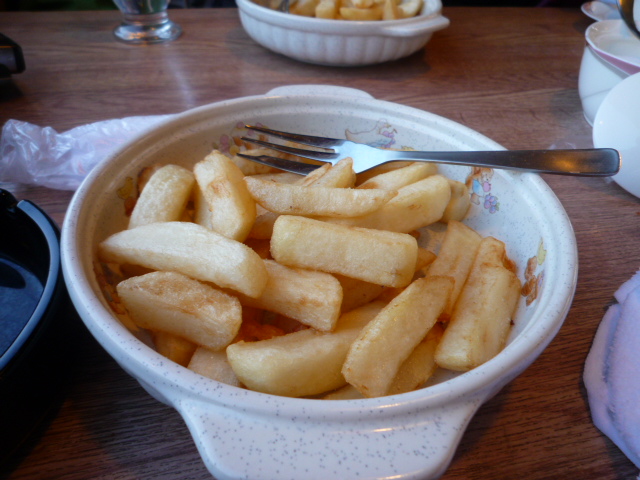 |
| A platter of french fries |
 |
| A platter of fried chicken (chicken karaage) |
 |
| The interior of the seaside cafeteria in Yoichi |
 |
| Another spectacular view of the Sea of Japan, as seen from inside the seaside cafeteria in Yoichi, during sunset |
 |
| The snowy land beside the seaside cafeteria in Yoichi during sunset, with the moon in the background |
 |
| A cliff by the Sea of Japan in Yoichi, during sunset |
 |
| The Sea of Japan by the beach which is popular in the summer season during the sunset |
 |
| The spectacular view of the Sea of Japan, as seen from inside the seaside cafeteria in Yoichi, just before nightfall |
 |
| The snowy land beside the seaside cafeteria in Yoichi during sunset |
By 4.30 p.m., the sun was beginning to set, as it always does in the winter season. We then resumed our journey back to Otaru via the same road we took towards Niseko. The route again took us through the coastal route by the Sea of Japan. Again, the natural beauty of the Sea of Japan made me capture some beautiful shots.
 |
| Driving along the coast of the Sea of Japan shortly after leaving Yoichi |
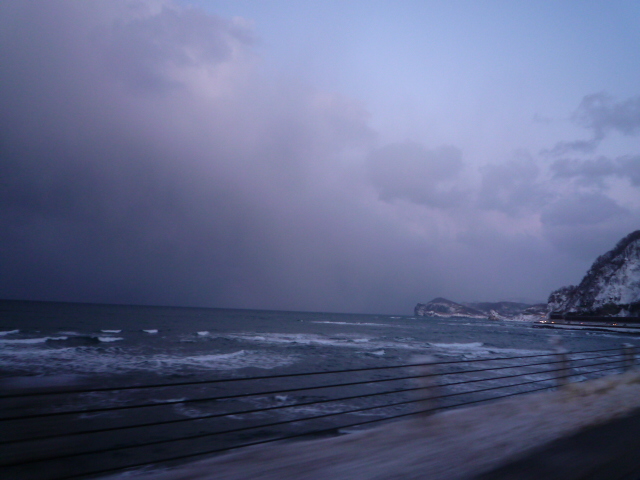 |
| The coast of the Sea of Japan while on the way back to Otaru |
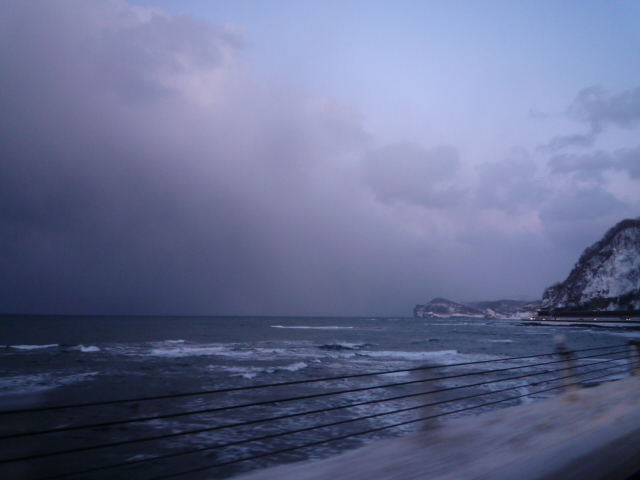 |
| Another view along the coast of the Sea of Japan while on the way back to Otaru |
 |
| The beautiful view while driving along the coast of the Sea of Japan during sunset |
As we neared the city of Otaru, we decided to stop by at Mount Tengu to see its winter and night appearance. The hill was really covered in snow, and used as a skiing area in winter. These are some pictures which I have taken before going up to Mount Tengu.
 |
| The skiing slope in Mount Tengu Otaru |
 |
| The entrance to the Otaru Tenguyama Ropeway Station |
We went inside the ropeway station to get some round tickets to and from the mountain peak. After getting our tickets, we were on the Otaru Tenguyama cable car by 5.15 p.m.. Here are some pictures I took while on the way up to Mount Tengu.
 |
| The Otaru Tenguyama Ropeway at the base shortly after we left it |
 |
| A view of the Otaru Tenguyama Ropeway and the city of Otaru at night |
 |
| A view of the city of Otaru at night from the Otaru Tenguyama Cable Car |
 |
| Another night view of the city of Otaru from the Otaru Tenguyama Cable Car |
At 5.20 p.m., we arrived at the Tenguyama Peak Station. As soon as we alighted the cable car, we immediately headed outside to see the beautiful scenery of the city lights at night.
There was also a mini-vehicle sliding slope at the peak of Mount Tengu. This is only open in the spring, summer, or autumn seasons.
 |
| The Otaru Tenguyama Ropeway peak station |
 |
| The night view of the city of Otaru from Mount Tengu |
 |
| The ski lifts at the peak of Mount Tengu |
After spending a few minutes in the open cold air outside the cable car station, we went to the Panorama Restaurant Tengu for a light dinner. I sat by the window which overlooked the city of Otaru. The views of Otaru were indeed spectacular, especially at night.
While at the Panorama Restaurant Tengu, I had a cup of hot chocolate and a mini Butadon set for dinner.
 |
| The skiing slope as seen from Panorama Restaurant Tengu |
 |
| A panoramic night view of the City of Otaru from Panorama Restaurant Tengu |
 |
| A cup of hot chocolate for myself |
 |
| The skiing slope and the city of Otaru at night as seen from Panorama Restaurant Tengu |
 |
| A mini Butadon set for myself |
 |
| The Christmas Tree in Panorama Restaurant Tengu |
 |
| The interior of Panorama Restaurant Tengu |
 |
| The logo of Panorama Restaurant Tengu |
 |
| The souvenir shop outside the Panorama Restaurant Tengu |
 |
| Another panoramic night view of the City of Otaru from Panorama Restaurant Tengu |
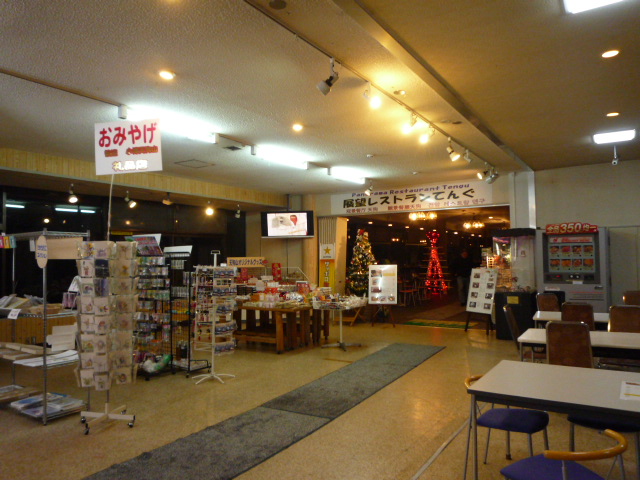 |
| The entrance in Panorama Restaurant Tengu |
 |
| The miniature bear outside Panorama Restaurant Tengu |
After spending some time at Mount Tengu Otaru, we decided to head to the Grand Park Hotel Otaru at 5.30 p.m.. We took the cable car down to the base station, and drove to the hotel.
After a journey time of almost 7 hours, we finally arrived at the Grand Park Hotel Otaru just before 7 o' clock in the evening. My mum then checked us in while I snapped a few pictures of the entrance hall.
 |
| The decoration tree in the Grand Park Hotel Otaru |
 |
| The grand entrance hall with Christmas decorations in the Grand Park Hotel Otaru |
 |
| The room where my brother and I slept |
After my mum checked us in, we were in our rooms by 7.15 p.m.. A few porters then came up with our baggage. With that, we had a light supper, and went to bed just before 1 o' clock that night.
Part 2 ~ The First Train Journey to New Chitose Airport
The next day, which was a Sunday (19 December), we woke up relatively late at around 11 o' clock that morning. From the very first moment I awoke, the views of the Sea of Japan from my room was spectacular. This made me snap a few images, after I had a shower and changed up to start the day.
 |
| The port of Otaru and the Sea of Japan in the early afternoon |
 |
| The Sea of Japan in the early afternoon |
At 12 noon, we got onto the car and drove to downtown Sapporo for lunch. The journey time between the Grand Park Hotel Otaru and downtown Sapporo. Here are some pictures that I can show to you if you like.
 |
| Our hotel as seen from our car |
 |
| The Sea of Japan beside the cities of Otaru and Ishikari |
 |
| Passing by some houses in Teine-ku, Sapporo |
 |
| Into downtown Sapporo with JR Tower Hotel Nikko and Sapporo Station in the background |
After we arrived at downtown Sapporo, the very first thing we did was to go the the JR Travel Service Center to Sapporo Station. We then exchanged my JR Hokkaido Rail Pass exchange voucher to a Hokkaido Rail Pass, for use on Limited Express trains for a free 4 days of my choice until 28 December.
At the Travel Service Center, I purchased my train ticket to New Chitose Airport. I was to be on the Rapid Airport train No. 152 bound for New Chitose Airport, which would depart from Sapporo Station at 3.25 p.m. (15 25). I was booked on a reserved seat ("u" seat), which cost me 1,340 yen (S$21.44).
As for the return journey to Otaru-chikko Station, I was booked on the Rapid Airport train No. 181 bound for Otaru, which would leave the airport at 6.04 p.m. (18 04). I was also booked on a reserved seat ("u" seat), which cost me 1,850 yen (S$29.60).
Airport is a dedicated rapid train service operating between New Chitose Airport and Sapporo, Otaru, and Asahikawa in Hokkaido, Japan. Many trains continue to and from Otaru or Asahikawa during the daylight and evening hours. Some trains terminate and start from Sapporo. The service's rolling stock currently uses 6-car 721 series, and 5-car 785 series and 789-1000 series EMUs.
Should a Rapid Airport train operate between New Chitose Airport and Asahikawa, they will function as Super Kamui limited express trains between Sapporo and Asahikawa, using 785 series and 789-1000 series EMUs.
There is no Green Car (first class) seating available on the Rapid Airport and Super Kamui limited express trains. However, reserved seats ("u" seats) are available at a cost of just 300 yen (S$4.80) (half the price for children and free for Japan Rail Pass holders). The fastest journey time between Sapporo and New Chitose Airport by train is only 36 minutes.
 |
| The sign to Sapporo Station in the ground floor of the JR Tower |
 |
| The ground floor of the JR Tower |
 |
| The surroundings outside Sapporo Station |
 |
| The Sapporo Station sign mounted above the entrance to the station concourse |
 |
| The Blue Christmas Tree with silver stars outside the entrance to the Sapporo Station concourse |
 |
| The entrance to the station concourse of Sapporo Station |
 |
| The December 2010 train timetable revision manual |
 |
| The interior of the Travel Service Center of Sapporo Station |
After I received my Hokkaido Rail Pass, I went up with my parents to a restaurant in the JR Tower Sapporo Station. As it was only 2.25 p.m., I still had an hour before my train to New Chitose Airport. I knew I had to be quick.
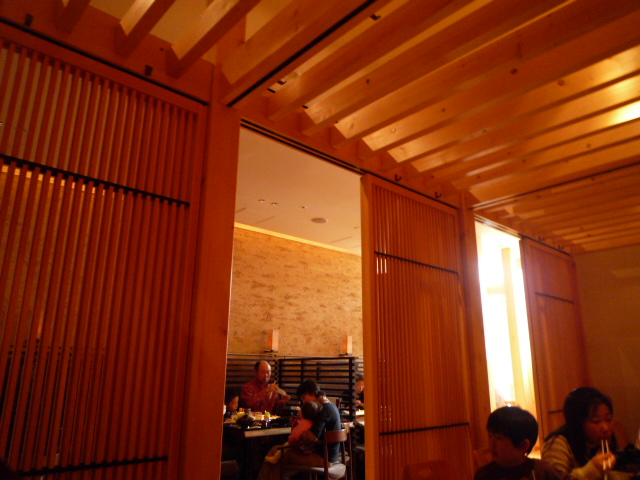 |
| Inside the restaurant in JR Tower |
 |
| A plate of fried prawn and asparagus |
 |
| My mum's udon noodle set |
 |
| My brother's tempura rice |
 |
| My dad's sushi set meal |
 |
| A yakitori platter |
 |
| An overall view of our meal |
The clock was already close to striking 3 o' clock by the time I finished eating. Immediately, I went down to Sapporo Station. According to the departure information board, my train would depart Sapporo at 3.25 p.m. from Track No. 5. Here are some pictures which I took while waiting for the Rapid Airport train No. 152 for New Chitose Airport.
 |
| The station concourse of Sapporo Station |
 |
| The departure information timings for Rapid "Airport" trains for New Chitose Airport |
 |
| Tracks No. 5 and 6 of Sapporo Station |
 |
| A 789-1000 series EMU set, operating on the Limited Express "Super Kamui" No. 25 bound for Asahikawa |
 |
| The LED destination panel found on 789-1000 series EMUs |
 |
| The reserved seat ("u" seat) logo found on 789-1000 series EMUs |
 |
| The departure information board for trains departing from Track No. 5 in Sapporo Station |
 |
| The station platform of Sapporo Station, facing the direction towards Otaru and Kutchan |
 |
| The station platform of Sapporo Station, facing the direction towards Asahikawa, Chitose, and Tomakomai |
 |
| Track No. 6 of Sapporo Station, with a KiHa 283 series DMU set operating as the Limited Express "Super Ozora" No. 9 bound for Kushiro on Track No. 7 |
At 3.20 p.m., a 785 series EMU set, operating on the Rapid Airport train No. 152 bound for New Chitose Airport finally entered Sapporo Station on Track No. 5. The train had arrived from Asahikawa earlier as the Limited Express Super Kamui No. 26, and was to undergo a change of direction at Sapporo.
With that, I boarded the train, and settled into my assigned seat No. 2A for the 36-minute journey to New Chitose Airport.
 |
| The interior of the 785 series EMU reserved seat ("u" seat) car |
 |
| My train ticket for the journey between Sapporo and New Chitose Airport |
 |
| The Sapporo Station platform, as seen from the Rapid "Airport" train No. 152 for New Chitose Airport |
At exactly 3.25 p.m., the Rapid Airport train No. 152 bound for New Chitose Airport, finally pulled out of Sapporo Station. With that, I was on my way for a 36-minute journey towards New Chitose Airport. Here are some pictures and videos which will explain the journey.
785系 快速エアポート152号 新千歳空港行き 札幌駅から発車とuシート
 |
| A view of my seat, 2A, shortly after leaving Sapporo |
 |
| The JR Hakodate Line tracks leading to Abashiri and Wakkanai, via Asahikawa |
 |
| The 785 series EMU reserved seat ("u" seat) cabin during final approach to Shin-sapporo Station |
 |
| The name plate of Shin-sapporo Station |
 |
| Passing by some housing areas in Atsubetsu-ku, Sapporo |
 |
| Passing by a snowy open land in Atsubetsu-ku, Sapporo |
 |
| Passing by some houses and a park |
 |
| Passing by Kitahiroshima, a suburb near Sapporo |
 |
| Some petrol stations and shops in Kitahiroshima |
 |
| A view of my seat, 2A, in its fully reclined position |
785系 快速エアポート152号 新千歳空港行き 千歳駅から南千歳駅
 |
| The 785 series EMU reserved seat ("u" seat) cabin during final approach to New Chitose Airport |
After a journey time of 36 minutes from Sapporo, I finally arrived at the New Chitose Airport terminal station at 4.01 p.m. (16 01), as planned. Before going up to the terminal building, I snapped some pictures on the platform.
 |
| The departure information indicator on the station platform of New Chitose Airport |
 |
| The LED destination panel on the 785 series EMU |
 |
| The 785 series EMU set which transported me to CTS earlier |
 |
| The station platform of New Chitose Airport Station |
 |
| The interior of the reserved seat ("u" seat) cabin of the 785 series EMU |
 |
| The ticket gates at New Chitose Airport Station |
After taking my usual pictures, I took the escalator up to the main terminal building. When I reached the terminal building, construction works were made on the top floor to make the connections to the international terminal easier.
 |
| The shopping area in the second floor of the main terminal building of New Chitose Airport |
 |
| The Japan Airlines domestic flight check-in counters in the main departure area of New Chitose Airport |
 |
| The departure flight information screen above the Japan Airlines domestic flight check-in counter |
 |
| The shopping area of the main terminal building of New Chitose Airport |
I then headed to the Flyers hobby shop located on the third floor. According to the shop owner, they were temporarily located on the third floor due to renovation works on the top floor. The top floor, which would have a direct passageway to the international terminal, was due to open somewhere in 2011.
 |
| A lineup of shops on the third floor during the renovation of the top floor |
 |
| Various aircraft models laid out in Flyers |
At Flyers, I purchased one plane model. The details are as follows:
1) Japan Airlines Boeing 747-446 "Oneworld" Hogan Wings Scale 1:500 (BJE2069)
.jpg) |
| Japan Airlines Boeing 747-446 "Oneworld" Hogan Wings Scale 1:500 (BJE2069) |
 |
| An overall view of the main shopping area as seen from the third floor |
 |
| A layout of shops on the second floor |
 |
| The domestic flight arrival lobby at New Chitose Airport |
 |
| The train departure information indicator in the domestic flight arrivals area of New Chitose Airport |
At around 5 o' clock, I decided to head back to New Chitose Airport Station in preparation for my train journey back to Otaru. When I reached the station, the station man told me that it was still early before my train back to Otaru. However, I told him that I was alright waiting on the platform for 45 minutes. Here are some pictures I took while waiting for the Rapid Airport train No. 181 bound for Otaru, which would later depart at 6.04 p.m. (18 04).
 |
| The passageway leading to New Chitose Airport Station |
 |
| The ticket gates at New Chitose Airport |
 |
| The name plate of New Chitose Airport Station |
 |
| The two platforms of New Chitose Airport Station filled with trains |
 |
| The front LED destination panel of the 789-1000 series EMU |
 |
| The LED destination panel of the 789-1000 series EMU |
 |
| The 789-1000 series EMU, operating on the Rapid "Airport" train No. 173 bound for Asahikawa via Sapporo on Track No. 2 at New Chitose Airport Station |
 |
| A clear view of the station platform of New Chitose Airport Station |
After approximately 45 minutes of waiting, a 6-car 721 series EMU operating on the Rapid Airport train No. 170 from Otaru finally arrived at 5.46 p.m. on Track No. 1. The train would soon become the Rapid Airport train No. 181 bound for Otaru, which would leave the airport at 6.04 p.m. (18 04).
As soon as the train was cleaned, I immediately boarded the train at 5.50 p.m., and settled into my assigned seat No. 10D. The journey to Otaru-chikko would take approximately 1 hour 06 minutes. Here are some pictures I took while waiting for a 6.04 p.m. departure.
 |
| The 721 series EMU, which would later take me back to Otaru-chikko as the Rapid "Airport" train No. 181 bound for Otaru |
 |
| The 721 series reserved seat ("u" seat) layout map |
 |
| One of the reserved seat ("u" seat) interiors of the 721 series EMU used on services between Otaru / Sapporo and New Chitose Airport |
 |
| One of the pairs of reserved seats ("u" seat) of the 721 series EMU used on services between Otaru / Sapporo and New Chitose Airport |
 |
| The rear view of one of the reserved seat ("u" seat) interiors of the 721 series EMU used on services between Otaru / Sapporo and New Chitose Airport |
 |
| The front view of one of the reserved seat ("u" seat) interiors of the 721 series EMU used on services between Otaru / Sapporo and New Chitose Airport |
After all the passengers for the train were on board, we finally pulled out of New Chitose Airport Station at 6.04 p.m., as planned. I was then on my 1 hour 05 minute-journey back to Otaru-chikko Station. Here are some pictures and videos which will explain the journey back to Otaru.
 |
| The station platform of New Chitose Airport Station as seen from the Rapid "Airport" train No. 181 for Otaru |
721系 快速エアポート181号 札幌方面小樽行き 新千歳空港駅から南千歳駅
 |
| The reserved seat ("u" seat) cabin as seen from my seat |
 |
| My return train ticket to Otaru |
 |
| Passing by Kitahiroshima city at night |
721系 快速エアポート181号 札幌方面小樽行き 札幌駅の到着到着放送
 |
| Arrival at Sapporo Station |
 |
| The rear view of the reserved seat ("u" seat) cabin while at Sapporo Station |
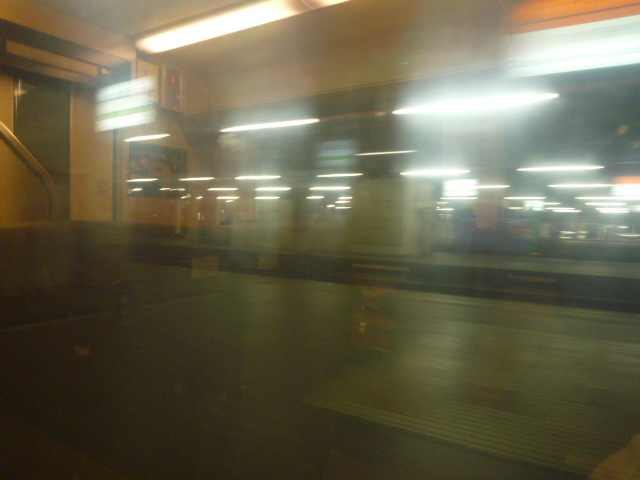 |
| Pulling out of Sapporo Station |
 |
| Arrival at Teine Station |
 |
| The coastline of the Sea of Japan at night |
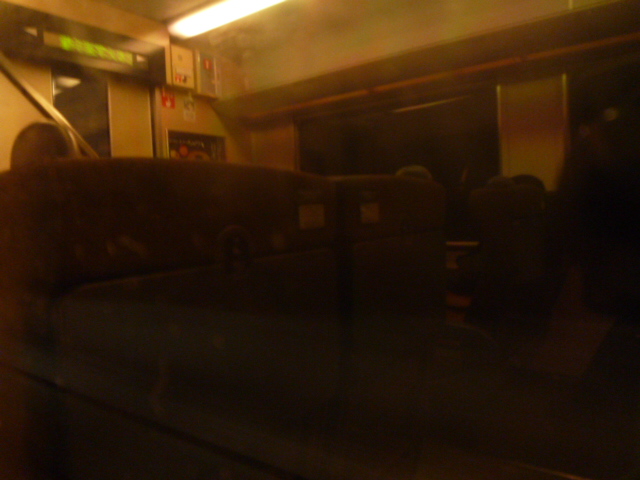 |
| Travelling along the coastline of the Sea of Japan at night while nearing the city of Otaru |
 |
| The reserved seat ("u" seat) cabin of the 721 series EMU while nearing Otaru-chikko |
After a journey time of 1 hour 06 minutes from New Chitose Airport, I finally arrived back at Otaru-chikko Station at 7.10 p.m. (19 10). Before leaving Otaru-chikko Station, I took some pictures inside the station.
 |
| The station platform of Otaru-chikko Station at night |
 |
| The station platform of Otaru-chikko Station at night facing the direction towards Sapporo |
 |
| The ticket gates at Otaru-chikko Station |
 |
| The station concourse of Otaru-chikko Station |
 |
| The entrance to Otaru-chikko Station |
After doing my usual photo-taking shots, I walked back to the Grand Park Hotel Otaru via the snowy walkway by the road. Once I reached the hotel room, I had dinner with my family and had a hot shower.
As I was to head to Obihiro the next day, I was thankful that I had made my seat reservation earlier that afternoon at Sapporo Station. With that, I decided not to sleep too late and went to bed just before midnight.
Part 3 ~ The Train Journey to Obihiro
The next morning, which was Monday (20 December), I woke up at around 9 o' clock after a good night's sleep.
The very first thing I did was to take a hot shower and change up to start the day right. I also took some pictures of the spectacular view of the Sea of Japan.
 |
| The port of Otaru and the Sea of Japan |
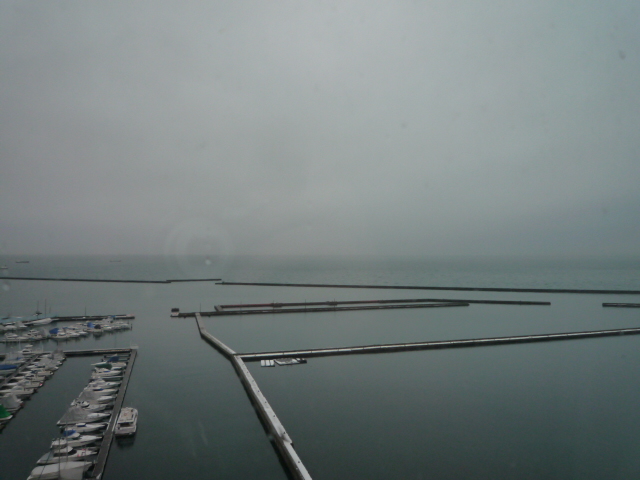 |
| The view of the Sea of Japan during a cloudy winter's morning |
 |
| Some ships at the port of Otaru |
It was about 9.50 a.m. by the time I finished preparing for my journey to Obihiro. As I had 50 minutes before my train to Sapporo, I decided to walk over to Otaru-chikko Station. The walk between the Grand Park Hotel Otaru and Otaru-chikko Station took approximately just 5 to 10 minutes.
 |
| The grand entrance hall of the Grand Park Hotel Otaru in the morning |
 |
| The overall view of Otaru-chikko Station |
After a short 10-minute walk from the Grand Park Hotel Otaru, I finally arrived at Otaru-chikko Station at 10 o' clock. My itinerary for the journey towards Obihiro would be to take the Rapid Airport train No. 110 bound for New Chitose Airport, which would depart Otaru-chikko Station at 10.40 a.m., and arrive at Sapporo Station at 11.06 a.m..
Upon arrival at Sapporo Station, I would connect to the Limited Express Super Ozora No. 5 bound for Kushiro, which would depart Sapporo Station at 11.51 a.m., and arrive at Obihiro Station at 2.13 p.m.. With that, I headed down to the station platforms to begin my journey towards the city of Obihiro.
 |
| The passageway to Otaru-chikko Station |
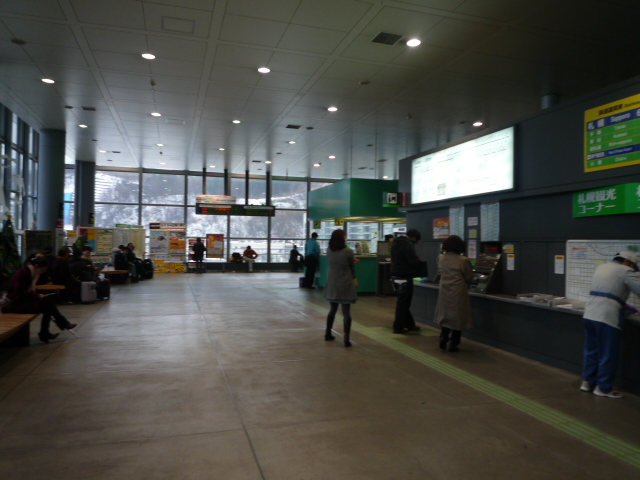 |
| The station concourse of Otaru-chikko Station in the morning |
 |
| The station platform of Otaru-chikko Station in the cloudy morning |
 |
| The departure information board in Otaru-chikko Station |
 |
| The station platform facing the direction towards Otaru and Kutchan |
 |
| The station platform facing the direction towards Sapporo |
After 25 minutes of waiting, the Rapid Airport train No. 110 bound for New Chitose Airport finally arrived at Otaru-chikko Station at 10.39 a.m.. With that, I immediately boarded the train through the reserved seat ("u" seat) carriage, and went to my assigned seat No. 5A for the 26-minute journey towards Sapporo.
At exactly 10.40 a.m., the train pulled out of Otaru-chikko Station. Here are some pictures during the journey to Sapporo.
 |
| The reserved seat ("u" seat) interior of the 721 series EMU operating on the Rapid "Airport" train No. 110 bound for New Chitose Airport |
 |
| Several housing apartments near Otaru-chikko Station |
 |
| The reserved seat ("u" seat) interior of the 721 series EMU operating on the Rapid "Airport" train No. 110 bound for New Chitose Airport, shortly after leaving Otaru-chikko Station |
 |
| Passing by a creek on the coast of the Sea of Japan |
 |
| A view of the Sea of Japan shortly after leaving the city of Otaru behind |
 |
| A view of the city of Otaru as seen beside the Sea of Japan |
 |
| Another view of the city of Otaru as seen beside the Sea of Japan |
 |
| The beautiful view of the Sea of Japan as seen on the JR Hakodate Line between Otaru-chikko and Teine |
 |
| The Sea of Japan as seen on the JR Hakodate Line between Otaru-chikko and Teine |
 |
| The coastline of the Sea of Japan as seen on the JR Hakodate Line between Otaru-chikko and Teine |
 |
| Passing by an old shack by the Sea of Japan |
 |
| The scenic view of the Sea of Japan as seen on the JR Hakodate Line between Otaru-chikko and Teine |
 |
| The coastline of the Sea of Japan as seen on the JR Hakodate Line |
 |
| The coastline of the Sea of Japan as seen on the JR Hakodate Line while nearing towards an area in Sapporo |
 |
| My train ticket for the sector between Otaru-chikko and Sapporo |
 |
| The cabin as seen from my seat |
 |
| On a railroad bridge on the JR Hakodate Line |
 |
| A pair of reserved seats ("u" seat) on the 721 series EMU operating on the Rapid "Airport" train No. 110 bound for New Chitose Airport |
After a journey time of 26 minutes from Otaru-chikko, I finally arrived at Sapporo Station at 11.06 a.m. on Track No. 5. I had approximately 45 minutes of layover at Sapporo before my next train to Obihiro. I decided to do my usual train spotting while waiting for my train to Obihiro. According to my Green Car (first class) ticket, the train I was to be on would be on board the Limited Express Super Ozora No. 5 bound for Kushiro for the section between Sapporo and Obihiro. The train would leave Sapporo at 11.51 a.m. from the same platform I arrived on earlier on the Rapid Airport train No. 110 for New Chitose Airport.
Obihiro is a city I am quite familiar with, since my 14th birthday. This place is well-known for its pork on rice glazed in special sauce, which the Japanese dub it as Butadon. This dish cannot be found in any other area in Japan, even in Tokyo, the nation's capital city. It takes approximately 2 hours 30 minutes to reach Obihiro from Sapporo by train. To allow travellers to access Obihiro from Sapporo by train, JR Hokkaido runs two limited express trains 12 times daily between Sapporo and Obihiro. They are mainly the Super Ozora, which continues to and from Kushiro, and the Super Tokachi.
The Super Ozora (スーパーおおぞら) is a limited express train service operated by Hokkaido Railway Company (JR Hokkaido) between Sapporo and Kushiro in Hokkaido, Japan. There are a total of seven trains per day in each direction, with the fastest journey time of approximately 3 hours 35 minutes. The service is capable of reaching a top speed of 130 km/h (80 mph).
The service commenced operations on 22 March 1997, and currently uses the KiHa 283 series DMUs as the main rolling stock. Services are normally formed of six or seven cars, but are occassionally lengthened between eight to ten cars on certain days and months. Green Car (first class) accommodation is available on all services, with the exception of trains No. 2 and 13.
The Super Tokachi (スーパーとかち) is a limited express train service operated by Hokkaido Railway Company (JR Hokkaido) between Sapporo and Obihiro in Hokkaido, Japan. There are a total of five services per day in each direction, with the fastest journey time taking 2 hour 25 minutes. The service currently used KiHa 261-1000 series DMUs and KiHa 283 series DMUs as its main rolling stock.
Green Car (first class) accommodation available on all services, with the exception of trains No. 5 and 8. The service is capable of reaching a top speed of 130 km/h (80 mph). Services are normally formed of four cars (KiHa 261 series DMUs) or five cars (KiHa 283 series DMUs), but may be lengthened between six to eight cars on certain days and months.
The service commenced operations as simply Tokachi (とかち) on 1 September 1990 using KiHa 183 series DMUs. From 27 July 1991, four Tokachi services were upgraded to Super Tokachi services using enhanced KiHa 183 series DMUs, which included a bi-level Green Car (first class) carriage.
From the start of the revised timetable on 11 March 2000, KiHa 283 series DMUs were introduced on these services. New and enhanced KiHa 261-1000 series DMUs were introduced on these services from 1 October 2007, which eventually displaced the older KiHa 183 series DMUs previously used.
From 1 October 2009, all the remaining KiHa 183 series DMUs were retired from Tokachi services, and the remaining two daily Tokachi return workings were upgraded to Super Tokachi services, utilising new KiHa 261-1000 series DMUs. As the Super Tokachi is relatively slower than the Super Ozora, many travellers will opt to take the Super Ozora between Sapporo and Obihiro whenever possible, although certain Super Ozora services may make additional stops.
The service commenced operations on 22 March 1997, and currently uses the KiHa 283 series DMUs as the main rolling stock. Services are normally formed of six or seven cars, but are occassionally lengthened between eight to ten cars on certain days and months. Green Car (first class) accommodation is available on all services, with the exception of trains No. 2 and 13.
The Super Tokachi (スーパーとかち) is a limited express train service operated by Hokkaido Railway Company (JR Hokkaido) between Sapporo and Obihiro in Hokkaido, Japan. There are a total of five services per day in each direction, with the fastest journey time taking 2 hour 25 minutes. The service currently used KiHa 261-1000 series DMUs and KiHa 283 series DMUs as its main rolling stock.
Green Car (first class) accommodation available on all services, with the exception of trains No. 5 and 8. The service is capable of reaching a top speed of 130 km/h (80 mph). Services are normally formed of four cars (KiHa 261 series DMUs) or five cars (KiHa 283 series DMUs), but may be lengthened between six to eight cars on certain days and months.
The service commenced operations as simply Tokachi (とかち) on 1 September 1990 using KiHa 183 series DMUs. From 27 July 1991, four Tokachi services were upgraded to Super Tokachi services using enhanced KiHa 183 series DMUs, which included a bi-level Green Car (first class) carriage.
From the start of the revised timetable on 11 March 2000, KiHa 283 series DMUs were introduced on these services. New and enhanced KiHa 261-1000 series DMUs were introduced on these services from 1 October 2007, which eventually displaced the older KiHa 183 series DMUs previously used.
From 1 October 2009, all the remaining KiHa 183 series DMUs were retired from Tokachi services, and the remaining two daily Tokachi return workings were upgraded to Super Tokachi services, utilising new KiHa 261-1000 series DMUs. As the Super Tokachi is relatively slower than the Super Ozora, many travellers will opt to take the Super Ozora between Sapporo and Obihiro whenever possible, although certain Super Ozora services may make additional stops.
 |
| The departure information board at Sapporo Station for trains departing from Track No. 5 |
 |
| The 721 series EMU set, which transported me to Sapporo earlier |
 |
| A 785 series EMU trainset, operating on the Limited Express "Suzuran" No. 2 bound for Muroran on Track No. 6 |
 |
| An out-of-service 789-1000 series EMU set on Track No. 4 |
 |
| The name plate for Sapporo Station |
 |
| The station platform for Sapporo Station in the early afternoon hours |
 |
| The KiHa 283 series DMU set, which would later take me to Obihiro as the Limited Express "Super Ozora" No. 5 bound for Kushiro |
 |
| The LED destination panel on the KiHa 283 series DMU in English |
 |
| The LED destination panel on the KiHa 283 series DMU in Japanese |
 |
| Track No. 5 of Sapporo Station |
At 11.40 a.m., the cleaners told the passengers that the train was ready for boarding. With that, I immediately boarded the train through Car No. 2 to get a clearer image of Car No. 3 which was the Green Car (first class) cabin.
I then found my assigned seat No. 3D, and immediately settled in. The seat next to me would stay empty until the train stopped at Minami-chitose Station.
I then found my assigned seat No. 3D, and immediately settled in. The seat next to me would stay empty until the train stopped at Minami-chitose Station.
 |
| The KiHa 283 series Green Car cabin |
 |
| A view of my seat, 3D, during boarding at Sapporo Station |
 |
| A single seat in the Green Car (first class cabin) on the KiHa 283 series DMU |
 |
| The rear view of the KiHa 283 series DMU Green Car (first class) cabin while waiting for departure from Sapporo Station |
 |
| The front view of the KiHa 283 series DMU Green Car (first class) cabin while waiting for departure from Sapporo Station |
At exactly 11.51 a.m., the train pulled out of Sapporo Station for a journey time of 3 hours 51 minutes to Kushiro. Here are some pictures which will explain the sector between Sapporo and Minami-chitose Station.
キハ283系 特急スーパーおおぞら5号 釧路行き 札幌駅から発車とグリーン車
 |
| The JR Hakodate Line tracks leading to Abashiri and Wakkanai via Asahikawa |
 |
| The Sheraton Hotel Sapporo |
 |
| My limited express train ticket for the sector between Sapporo and Obihiro |
 |
| At Shin-sapporo Station |
 |
| Passing by an open field in Atsubetsu-ku, Sapporo |
 |
| Passing by an open field covered in snow in Kitahiroshima |
 |
| The KiHa 283 series DMU Green Car (first class) cabin from my seat |
キハ283系 特急スーパーおおぞら5号 釧路行き 車窓から南千歳駅に到着
At 12.17 p.m., the train made a brief stop at Minami-chitose Station. Quickly, more passengers began to board the train. Most of the transfer passengers were from New Chitose Airport.
A gentleman then came into the Green Car cabin and occupied seat No. 3C. So there goes my personal space! He, too, was heading to Obihiro. After a while, the train departed from Minami-chitose Station. Nevertheless, here are some pictures during the journey between Minami-chitose and Obihiro.
 |
| My seat, 3D, during stopover at Minami-chitose Station |
 |
| Passing by the Toyota Rent-a-car area near New Chitose Airport |
 |
| The Toyota Rent-a-car area near CTS where we rented our car |
 |
| Passing by Oiwake Station |
 |
| A cup of orange juice for myself |
 |
| Passing Shin-yubari Station |
 |
| Crossing a river and a road bridge in the small city of Yubari |
 |
| Some constructions works ongoing in the city of Yubari |
 |
| A snowy hill in Yubari |
 |
| The KiHa 283 series DMU Green Car (first class) cabin in a tunnel between Shin-Yubari and Shimukappu |
 |
| Passing by a snow-covered forest in the village of Shimukappu |
 |
| A snow-covered mountain and forest in Shimukappu |
 |
| Another snow-covered mountain and forest |
 |
| A snowy road and hillside between Yubari and Shimukappu |
 |
| Another snowy forest between Shimukappu and Tomamu |
 |
| An open field with a some trees covered in a blanket of snow |
 |
| A coniferous forest in the village of Shimukappu |
 |
| A coniferous forest and a mountain covered in winter storm clouds |
 |
| The KiHa 283 series DMU Green Car cabin between Shimukappu and Tomamu |
 |
| Passing by a snow-covered mountain and forest in the village of Shimukappu while approaching Tomamu Station |
 |
| At Tomamu Station |
 |
| A forest with a cloud about to pour more snow |
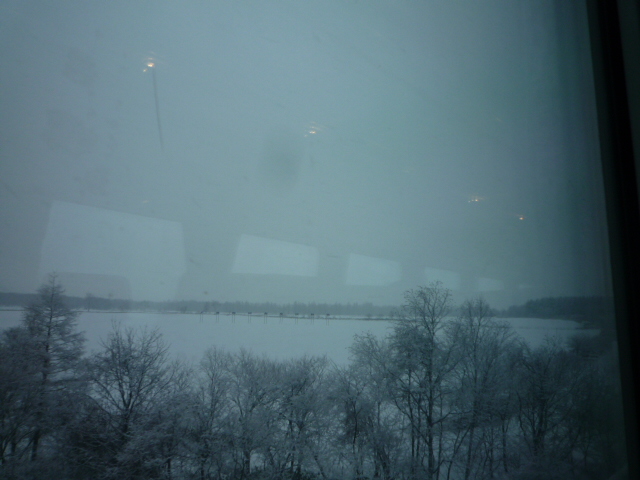 |
| A snowy open land between Tomamu and Shintoku |
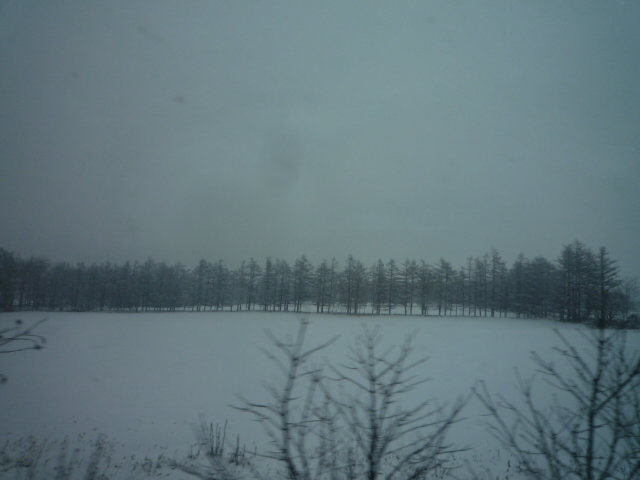 |
| Another snow-covered field near Tomamu |
 |
| A snow-covered open land while nearing Shintoku Station |
 |
| The rear view of the KiHa 283 series DMU Green Car (first class) cabin during approach to Shintoku Station |
 |
| A view of my seat, 3D, during the journey to Obihiro |
 |
| The snowy town of Shintoku |
 |
| A snowy landscape shortly after leaving Shintoku Station |
 |
| The KiHa 283 series DMU Green Car (first class) cabin shortly after leaving Shintoku Station |
 |
| A pair of Green Car (first class) seats on the KiHa 283 series DMU shortly after leaving Shintoku |
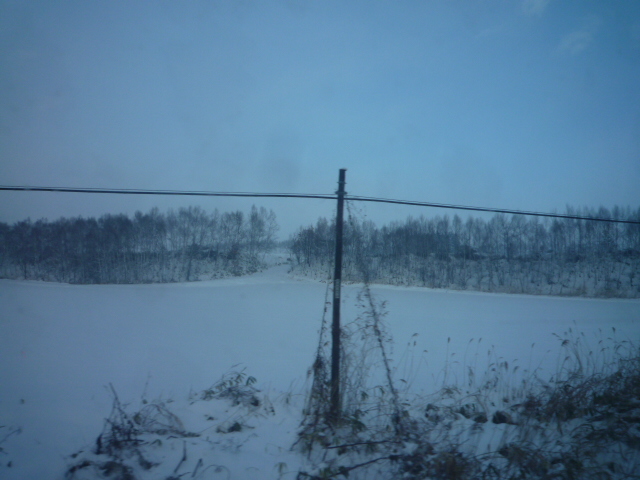 |
| The snow-covered land by a forest |
 |
| A snowy road and landscape while getting closer to Obihiro |
 |
| A single Green Car (first class) seat on the KiHa 283 series DMU, while nearing Obihiro |
 |
| The cell phone use area in the KiHa 283 series DMU while approaching Obihiro |
After a journey time of 2 hours 22 minutes from Sapporo, I finally arrived at my destination, Obihiro Station, at 2.13 p.m. (14 13) on Track No. 1, as planned. Before going down to have my lunch, I took a picture of the train before it left for Kushiro.
 |
| The KiHa 283 series DMU train operating on the Limited Express "Super Ozora" No. 5 service between Sapporo and Kushiro at Obihiro Station |
 |
| Tracks No. 1 and 2 of Obihiro Station |
 |
| The Green Car logo on the KiHa 283 series DMU |
At 2.20 p.m., I went down to a Butadon cafe beside the station concourse to have my lunch. At the cafe, I ordered myself a huge bowl of Obihiro's famous Butadon. Knowing that I had only 25 minutes before my train back to Sapporo, I could not take too long to eat and purchase the 10 bottles of Butadon sauce. The taste of the pork was extremely tender and fresh, as the flavour melted in my mouth.
 |
| The passageway to a shopping area below Obihiro Station |
 |
| The logo of the Butadon cafe at Obihiro Station |
 |
| The interior of the Butadon cafe in Obihiro Station |
 |
| A mouth-watering bowl of Obihiro's famous Butadon for myself |
After finishing my mouth-watering bowl of Butadon, I decided to purchase 10 bottles of the special Butadon sauce, each with a capacity of 360 ml. The bottles then cost me 7,800 yen (S$124.80). The bag was relatively heavy, but I had to hurry back to the platform for my train back to Sapporo.
By 2.40 p.m., I was back on the platform towards Shintoku. The train that I was to be taking for the sector between Obihiro and Sapporo would be the Limited Express Super Ozora No. 10 bound for Sapporo. The train would leave Obihiro at 2.56 p.m. (14 56) from Track No. 4.
 |
| Tracks No. 3 and 4 of Obihiro Station |
 |
| The departure information board showing the details of my train back to Sapporo |
 |
| The name plate for Obihiro Station |
 |
| The station platforms of Obihiro Station facing the direction towards Ikeda and Kushiro |
 |
| The station platforms of Obihiro Station facing the direction towards Shintoku and Sapporo |
 |
| Track No. 4 of Obihiro Station |
After 15 minutes of waiting, the Limited Express Super Ozora No. 10 bound for Sapporo finally arrived at Obihiro Station at 2.55 p.m. on Track No. 4. With that, I immediately boarded the Green Car (first class) cabin and found my assigned seat No. 1D. The seat next to me would stay empty throughout the journey.
 |
| The KiHa 283 series DMU LED destination panel towards Sapporo in Japanese |
 |
| The KiHa 283 series DMU LED destination panel towards Sapporo in English |
 |
| The Green Car (first class) cabin of the KiHa 283 series DMU while at Obihiro Station |
At exactly 2.56 p.m. (14 56), the Limited Express Super Ozora No. 10 bound for Sapporo, finally pulled out of Obihiro Station. The journey between Obihiro and Sapporo would take 2 hours 21 minutes. Here are some pictures and videos which will explain the first sector of my journey between Obihiro and Sapporo.
キハ283系 特急スーパーおおぞら10号 札幌行き 帯広駅から発車
 |
| About to cross under a snowy road bridge in Obihiro |
 |
| My limited express train ticket for the sector between Obihiro and Sapporo |
 |
| A view of my seat, 1D, shortly after leaving the city of Obihiro |
 |
| The front view of the KiHa 283 series DMU Green Car (first class) cabin shortly after leaving Obihiro behind |
 |
| Two cups of orange juice for myself |
 |
| The snowy road and landscape between Obihiro and Tokachi-shimizu |
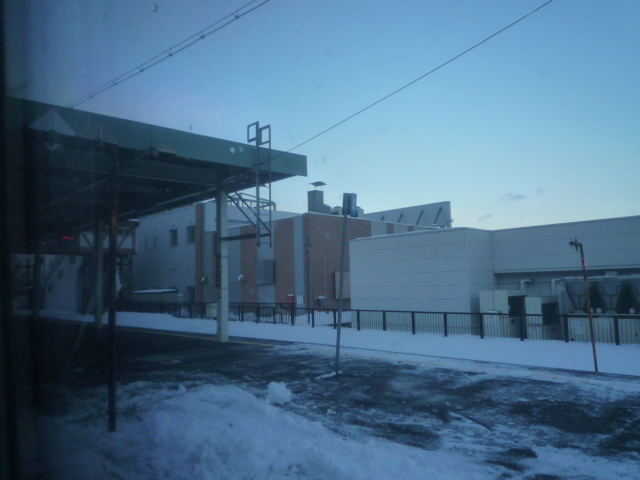 |
| Waiting for track clearance at Tokachi-shimizu Station for a train bound for Obihiro to arrive |
 |
| Meeting up with the Limited Express "Super Tokachi" No. 5 bound for Obihiro while waiting for track clearance at Tokachi-shimizu Station |
 |
| Leaving Tokachi-shimizu Station after waiting for track clearance |
 |
| A snowy open land hidden behind some trees beside the JR Nemuro Main Line tracks |
 |
| The rear view of the KiHa 283 series DMU Green Car (first class) cabin during travel on the JR Nemuro Main Line |
 |
| A view of my seat, 1D, during the journey on the JR Nemuro Main Line while on approach towards Shintoku Station |
 |
| The name plate of Shintoku Station |
 |
| The snowy scenery shortly after departure from Shintoku Station |
 |
| Passing by a snowy landscape and forest while on the JR Sekisho Line between Shintoku and Tomamu |
 |
| The snowy scenery as seen on the JR Sekisho Line bridge between Shintoku and Tomamu |
 |
| Another snowy landscape while getting slightly closer to Tomamu Station |
 |
| A snowy landscape and mountain between Shintoku and Tomamu |
 |
| Passing by another snowy forest and hillside while nearing Tomamu Station |
 |
| Stopping at Tomamu Station |
 |
| Meeting up with the Limited Express "Super Ozora" No. 7 bound for Kushiro at Tomamu Station |
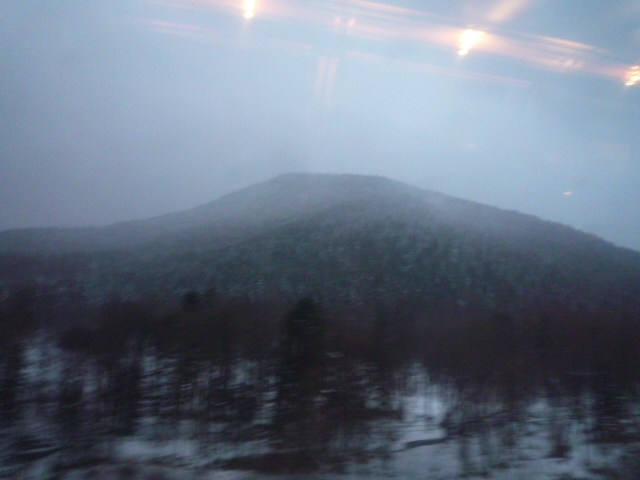 |
| A snow-covered mountain partly hidden in winter clouds |
 |
| An open land with the mountain covered in snow shortly after leaving Tomamu Station |
 |
| Passing by a snowy road and forest in Shimukappu |
 |
| Passing by a snowy road bridge while in the village of Shimukappu |
 |
| Passing by a snowy landscape during sunset between Shimukappu and Tomamu Stations |
 |
| Passing by some village houses in Shimukappu |
 |
| The KiHa 283 series DMU Green Car cabin in a tunnel between Tomamu and Shimukappu |
 |
| Passing by a mountain in Shimukappu during sunset |
キハ283系 特急スーパーおおぞら10号 札幌行き 車窓から新夕張駅を通過
 |
| Passing by the Toyota Rent-a-car area near New Chitose Airport, while approaching Minami-chitose Station |
 |
| At Minami-chitose Station, while meeting the luxurious Overnight Limited Express "Cassiopeia" bound for Ueno in the Greater Tokyo Area |
 |
| The luxurious Overnight Limited Express "Cassiopeia" about to leave Minami-chitose Station, heading to Ueno in the Greater Tokyo Area |
 |
| A view of my seat, 1D, while at Minami-chitose Station |
 |
| The KiHa 283 series DMU Green Car (first class) cabin while at Minami-chitose Station |
 |
| Passing through Chitose Station |
 |
| Passing through Minami-chitose Station |
 |
| At Shin-sapporo Station |
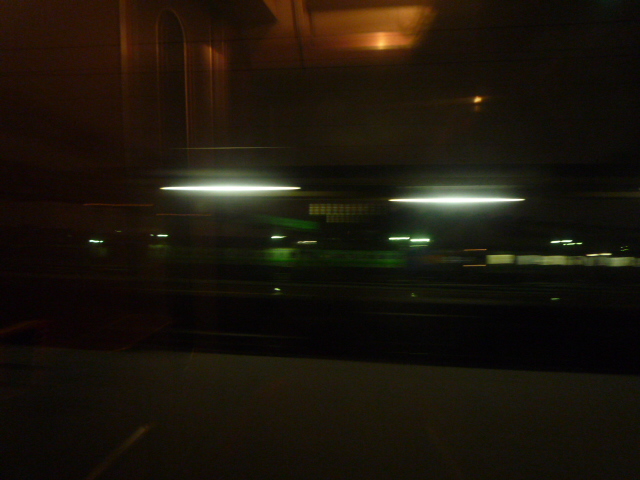 |
| Passing through Shiroishi Station |
After travelling from Obihiro for about 2 hours 21 minutes, I finally arrived at the Sapporo terminal station at 5.17 p.m. (17 17) on Track No. 5. The train was then to be taken out of service after arrival at Sapporo terminal. According to my schedule, I had approximately 23 minutes before my next train back to Otaru-chikko Station.
The train I was to take back to Otaru-chikko was the Rapid Airport train No. 171 bound for Otaru, which would leave Sapporo at 5.44 p.m. (17 44) from Track No. 4. While waiting, I decided to do some spotting before and when I headed to Track No. 4 for my train back to Otaru-chikko.
 |
| The KiHa 283 series DMU Green Car (first class) cabin after arrival at the Sapporo terminal station |
 |
| The KiHa 283 series DMU that took me back to Sapporo earlier |
 |
| The KiHa 283 series DMU LED destination panel, indicating that the train is not in service |
 |
| The Green Car logo on the KiHa 283 series DMU train |
 |
| The station platforms of Sapporo Station in the early evening hours |
 |
| A KiHa 261 series DMU set, operating on the Limited Express "Super Soya" No. 3 bound for Wakkanai on Track No. 5 of Sapporo Station |
 |
| Tracks No. 3 and 4 of Sapporo Station |
After 23 minutes of waiting, a 6-car 721 series EMU trainset operating on the Rapid Airport train No. 171 bound for Otaru finally arrived at Sapporo Station at 5.40 p.m. on Track No. 4.
With that, I immediately boarded the train through the reserved seat ("u" seat) car, and settled into my assigned seat No. 3A. The journey back to Otaru-chikko would take approximately 26 minutes.
At exactly 5.44 p.m. (17 44), the Rapid Airport train No. 171 bound for Otaru pulled out of Sapporo Station. Here are some pictures and a video which will explain the final sector between Sapporo and Otaru-chikko.
 |
| The reserved seat ("u" seat) interior of the Rapid "Airport" train No. 171 bound for Otaru |
721系 快速エアポート171号 小樽行き 札幌駅から発車とuシート
 |
| The reserved seat ("u" seat) interior of the Rapid "Airport" train No. 171 bound for Otaru from my seat |
 |
| My reserved seat ticket for the final sector between Sapporo and Otaru-chikko |
 |
| At Kotoni Station |
 |
| At Teine Station |
 |
| Travelling along the dark coastline of the Sea of Japan |
 |
| The rear view of the 721 series EMU reserved seat ("u" seat) cabin while approaching Otaru |
After 26 minutes of travelling on the JR Hakodate Line, I finally arrived back at my terminal station, Otaru-chikko, at 6.10 p.m. (18 10). As I alighted the train, I took some pictures along the station platform before leaving.
 |
| Track No. 1 of Otaru-chikko Station shortly after alighting |
 |
| The station platform facing towards Otaru and Kutchan |
 |
| The station platform towards Sapporo |
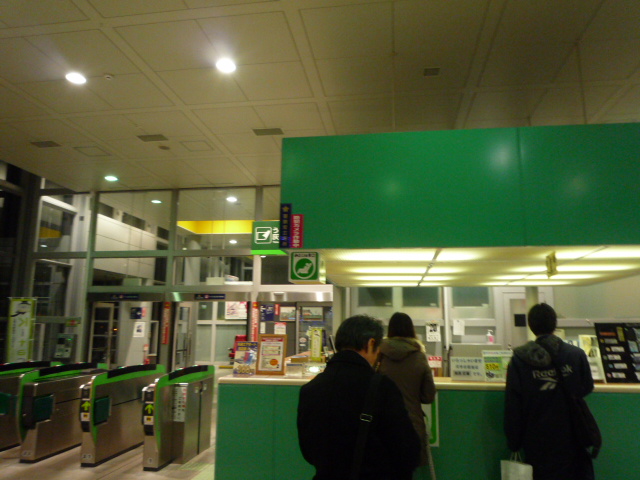 |
| The ticket booth and ticket gates at Otaru-chikko Station |
 |
| The station concourse of Otaru-chikko Station |
After I left the station, I walked through Wing Bay Otaru to access my hotel. I then took the hotel elevator back up to my room. That night, I had a sumptuous dinner with my family, did some personal things, and went to bed before 1 o' clock that morning.
Part 4 ~ A Day Of Exploring Otaru
The next day, which was a Tuesday (21 December), I woke up relatively late at around 10.30 a.m.. I immediately took a shower and changed up for the start of the day. All of us were awake by 10.45 a.m.. With that, I took some pictures of the Sea of Japan.
 |
| A view of the port of Otaru and the Sea of Japan in the early winter afternoon |
 |
| A view of Otaru port from my room |
 |
| A view of the Sea of Japan from my room |
 |
| The hotel lobby by the grand entrance hall |
At 11 o' clock, we went down to the car basement to get our car. Our very first stop was at Victoria Station for lunch. The restaurant was just a 10-minute drive from our hotel.
 |
| Driving around Otaru |
 |
| Outside Victoria Station Otaru |
Once we reached Victoria Station Otaru, we went inside to ask for a table for the four of us. At Victoria's, we ordered several items, whilst I had a mixed grill of beef and chicken for myself.
 |
| The interior of Victoria Station Otaru |
 |
| The food menu for Victoria Station Otaru |
 |
| The scenery of Otaru from the restaurant |
 |
| A plate of french fries and sausages |
 |
| Chicken karaage and potato wedges |
 |
| A mixed beef and chicken grill for myself |
 |
| A platter of french fries for my brother |
 |
| Another interior view of Victoria Station Otaru |
After having lunch at Victoria's, our next stop was Mount Tengu, to see what was skiing like there. We managed to play sliding down the slope while at the base of Mount Tengu. Unfortunately, I accidentally broke my watch whilst sliding down at one time. With that, I decided to have it repaired once we were back at Wing Bay Otaru.
 |
| The car parking area beside the Mount Tengu Ropeway Station |
 |
| The skiing slope at Mount Tengu Otaru |
 |
| The car parking area beside the skiing slope |
 |
| Another view of the skiing slope at Mount Tengu Otaru |
 |
| Outside the Otaru Tenguyama Ropeway station |
 |
| Inside the Otaru Tenguyama Ropeway station |
After spending some time at Mount Tengu, we decided to go and see a fish market around downtown Otaru. Before 2011, the market had a dining area beside it where they directly cooked and served their customers. They would be open from 10 a.m. to 4.30 p.m. daily except Sundays and national holidays. Here are some pictures whilst at the seafood market.
 |
| Passing by Otaru Harbour on the way to the fish market |
 |
| The exterior view of the seafood market in Otaru |
 |
| Several scallops, oysters and clams available fresh from the sea for sale |
 |
| The miniature statue of a bear outside the seafood market |
 |
| Three scallops being grilled on the barbecue griller |
 |
| One of the scallops being cut |
 |
| Several advertisement banners at the entrance to the fish market |
 |
| Marinating the grilling scallops with soy sauce (soya sauce) |
 |
| Two raw oysters on a metal plate |
 |
| The two raw oysters ready to be eaten |
 |
| The two grilled scallops ready to be eaten |
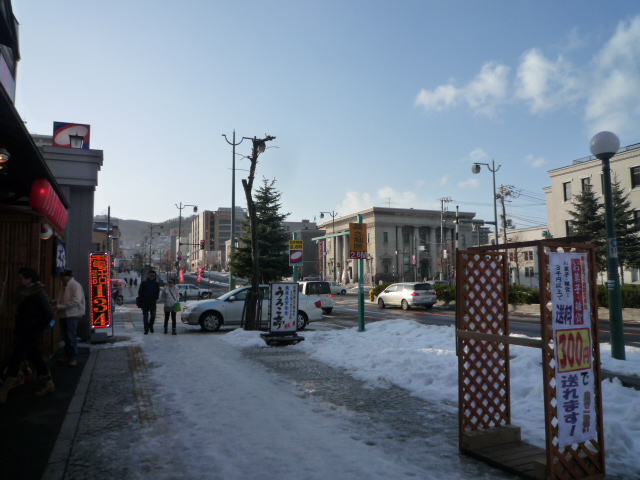 |
| A street beside the seafood market in Otaru |
 |
| A street beside a road near the seafood market in Otaru |
 |
| Two more scallops being grilled |
 |
| The two scallops being grilled, with one of them having an open shell |
 |
| One more oyster for consumption |
 |
| Two more scallops for consumption |
 |
| Two oysters and a clam being grilled on the barbecue griller |
 |
| The grilled clam ready to be eaten |
 |
| Two slightly grilled oysters ready to be eaten |
After having a snack at the seafood market, we decided to drive up to a mountain to have some nice, fresh air over the breathtaking scenery over the Sea of Japan. There was also a cemetery above the sightseeing spot. A golden bodhisattva statue of Guanyin (Japanese: 観音; Kannon) stood over the cemetery, acting as the its guardian for the deceased.
 |
| The Sea of Japan with a breakwater in the background |
 |
| About to commence climbing up the mountain with the Otaru Aquarium and a theme park in the background |
 |
| A view of the disused theme park from the mountain, with the ferris wheel visible |
 |
| A few fields of natural vegetation in the mountain |
 |
| A mountain hotel near the peak |
 |
| A cliff beside the Sea of Japan |
 |
| The Sea of Japan with a rock island and few natural vegetation |
 |
| The Sea of Japan with a lighthouse and a house far up ahead |
 |
| A beautiful view of the Sea of Japan on a clear winter's day in Otaru |
 |
| Another beautiful view of the Sea of Japan on a clear winter's day in Otaru |
 |
| And another beautiful view of the Sea of Japan on a clear winter's day in Otaru |
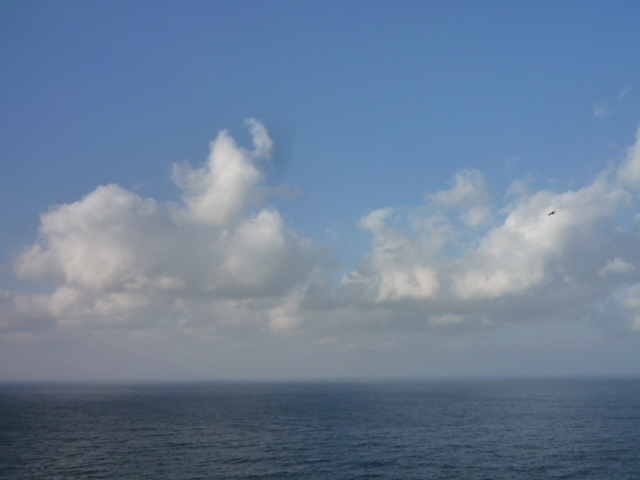 |
| A very clear and beautiful view of the Sea of Japan on a clear winter's day in Otaru |
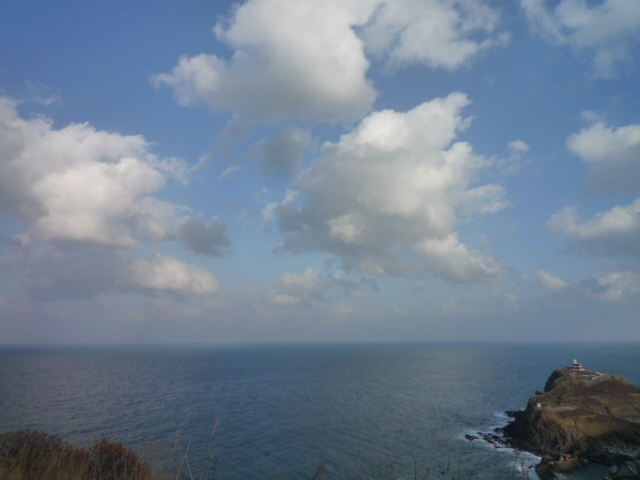 |
| Another very clear and beautiful view of the Sea of Japan on a clear winter's day in Otaru |
 |
| An even clearer and more beautiful view of the Sea of Japan on a clear winter's day in Otaru |
 |
| A car parking area on the mountain |
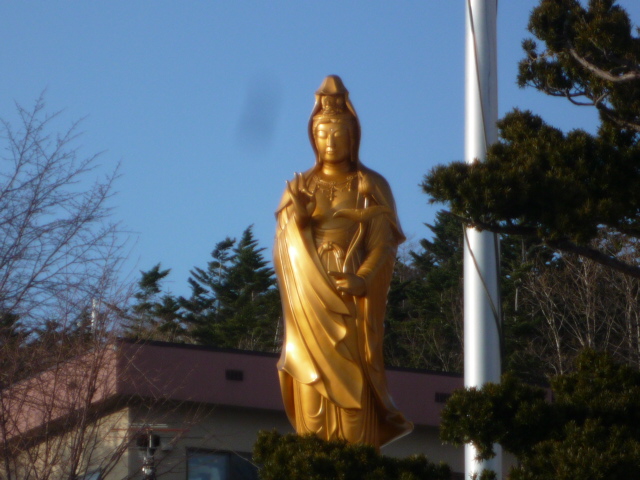 |
| The golden Guanyin statue on the top of the mountain guarding the cemetery |
 |
| The cemetery on the top of the mountain |
 |
| The Sea of Japan from another viewing point of the mountain |
 |
| A cliff and a seal farm beside the Sea of Japan |
 |
| Another cliff beside the Sea of Japan |
 |
| An abandoned house on the mountain |
After exploring around the mountain, we went to Homac Super Depot Department Store to purchase some necessities for home. On the way back to the Grand Park Hotel Otaru, we stopped by at Otaru Station.
My mum said that we had plans to go to Lake Toya the next day. When we reached Otaru Station, I purchased my train tickets for the journey between Otaru-chikko and Lake Toya.
 |
| Passing by a hot spring (onsen) house |
 |
| The car parking area outside Homac Super Depot Department Store |
 |
| The logo of Homac Super Depot Department Store |
 |
| The entrance to Homac Super Depot Department Store |
 |
| Several mountains from the car parking area near Homac Super Depot Department Store |
 |
| The exterior view of Homac Super Depot Department Store |
 |
| Otaru Canal during sunset |
 |
| Nearing Otaru Station |
 |
| The station concourse of Otaru Station |
 |
| Inside the ticket reservation office of Otaru Station |
 |
| Some buildings near Otaru Station |
After a day of exploring around Otaru, we decided to head back to the Grand Park Hotel Otaru at 3.30 p.m.. We then had a 45-minute rest in the hotel room. At around 4.20 p.m., we went down to Wing Bay Otaru.
 |
| The Sea of Japan during sunset as seen from my room |
 |
| The grand entrance hall of the Grand Park Hotel Otaru in the evening with decorations for Christmas |
 |
| Near the entrance to Wing Bay Otaru |
 |
| A miniature tree in the hotel lobby of the Grand Park Hotel Otaru |
While my mum and brother went to shop, my dad and I went to a watch and clock shop. I then asked the shop owner whether he could fixed my watch. The owner then told me that something went loose and the valve needed replacing. Within 10 minutes, my watch was as good as new.
I then paid the man and thanked him for his help. With that, we went back to the hotel room to have a good rest for the evening.
At around 9.10 p.m., we were filling rather hungry. My dad decided to being us to a sushi restaurant for dinner. The ride to the restaurant took about 15 minutes. This restaurant was known as Sushizanmai. While there, we ordered several sushi plates and some side dishes. This dinner was indeed a delicious sushi dinner.
 |
| The exterior of Sushizanmai sushi restaurant at night |
 |
| A variety of sashimi items on a table counter |
 |
| The interior of Sushizanmai |
 |
| A plate of one unagi (eel) sushi |
 |
| A cup of chawanmushi for myself |
 |
| A sushi platter for my mum |
 |
| A sushi platter for my dad |
 |
| A platter of flounder fin sushi |
 |
| Another large platter of various sushi |
 |
| A plate of beef sushi and aburi sushi for myself |
 |
| Various fishes swimming in a fish tank in Sushizanmai |
 |
| A road in Otaru late at night |
 |
| Outside the restaurant after dinner |
The clock was already showing 10.10 p.m. by the time we finished our dinner. With that, we paid our bill, and drove back to the Grand Park Hotel Otaru. We managed to arrive back at our hotel by 10.30 p.m..
 |
| The main hotel lobby late at night |
 |
| A view of the room I shared with my brother that night |
 |
| A view of my parents' room late that night |
As soon as we were back in our rooms, we immediately took a hot shower, and did some personal duties. We decided not to sleep too late that night, as we had a journey to Lake Toya the next day. With that, we went to bed just before midnight.
Part 5 ~ A Day in Lake Toya
The next day, which was a Wednesday (22 December), I woke up at around 8.15 a.m. after a good night's sleep. I immediately had a shower and changed up for the start of the day. At the same time, I took some good pictures of the Sea of Japan.
 |
| A view of the port of Otaru and the Sea of Japan in the early morning |
 |
| A view of the port of Otaru in the early morning |
 |
| A view of the Sea of Japan in the early morning |
By 8.40 a.m., all of us were awake and we all had a good shower. I then left the hotel room for Otaru-chikko Station at 8.50 a.m.. My parents would then do their usual drive to Lake Toya, but would remember to pick me up from Toya Station.
 |
| The grand entrance hall of the Grand Park Hotel Otaru during the mid-morning hours |
 |
| In the passageway to Otaru-chikko Station |
 |
| The entrance to Otaru-chikko Station in the mid-morning |
 |
| The station concourse of Otaru-chikko Station in the mid-morning |
After a 10-minute walk from the Grand Park Hotel Otaru, I was in Otaru-chikko Station at around 9 o' clock. With that, I was on the station platform by 9.10 a.m.. Surprisingly, I then saw my parents waving at me from the station platform, saying that they will meet me at Toya Station.
According to my schedule, the train I was to take to Sapporo from Otaru-chikko would be the Rapid Airport train No. 100 bound for New Chitose Airport. The train would leave the station at 9.40 a.m. from Track No. 2. Here are some pictures I took on the platform while waiting for the Rapid Airport train No. 100 bound for New Chitose Airport.
 |
| The departure information board warning passengers to beware of passing trains |
 |
| The departure information board showing the details of my train |
 |
| An out-of-service 721 series EMU train passing Otaru-chikko Station |
 |
| An overall view of the station platform of Otaru-chikko Station |
 |
| The station platform of Otaru-chikko Station with Wing Bay Otaru and the Grand Park Hotel Otaru being seen |
 |
| The name plate of Otaru-chikko Station |
After 25 minutes of waiting, the Rapid Airport train No. 100 bound for New Chitose Airport, finally entered Otaru-chikko Station at 9.39 a.m.. With that, I boarded the reserved seat ("u" seat) car and settled into my assigned seat No. 9A for the 26-minute journey to Sapporo. At exactly 9.40 a.m., the train left Otaru-chikko Station for the 1 hour 06-minute journey to New Chitose Airport. Here are some pictures I took during the sector between Otaru-chikko and Sapporo.
 |
| The interior of the reserved seat ("u" seat) car on the Rapid "Airport" train No. 100 to CTS |
 |
| The Sea of Japan flowing gracefully shortly after leaving Otaru-chikko |
 |
| A coast line along the Sea of Japan |
 |
| A view of my seat, 9A, during the journey to Sapporo |
 |
| The Sea of Japan while nearing Zenibako Station |
 |
| Passing through Zenibako Station |
 |
| A clear view of the Sea of Japan on the train |
 |
| A clearer view of the Sea of Japan on the train |
 |
| An even clearer view of the Sea of Japan on the train |
 |
| An even more clear view of the Sea of Japan on the train |
 |
| My train ticket for the sector between Otaru-chikko and Sapporo |
 |
| Meeting up with the most luxurious Overnight Limited Express "Cassiopeia", which had arrived from Ueno in Tokyo earlier |
 |
| On a railroad bridge between Teine and Kotoni Stations |
 |
| The rear view of the interior of the reserved seat ("u" seat) car on the Rapid "Airport" train No. 100 to CTS |
After a journey time of 26 minutes from Otaru-chikko, I arrived at Sapporo Station at 10.06 a.m. on Track No. 5. I had approximately half an hour before my next train to Toya. The train that I would be on for the sector between Sapporo and Toya would be the Limited Express Super Hokuto No. 10 bound for Hakodate.
The train would depart from Sapporo at 10.37 a.m. from Track No. 8. While that, I decided to take some pictures on Tracks No. 5 and 8 while waiting for my train.
The Hokuto and Super Hokuto are limited express train services that run between Sapporo and Hakodate in Hokkaido, Japan. The fastest journey time between Sapporo and Hakodate is approximately 3 hours. As the Hokuto is relatively slower than the Super Hokuto, many travellers will opt to take the Super Hokuto whenever possible when travelling between Sapporo and Hakodate.
 |
| A KiHa 261-1000 series DMU set, operating on the Limited Express "Super Tokachi" No. 3 bound for Obihiro |
 |
| The Green Car (first class) cabin of the KiHa 261-1000 series DMU set used for "Super Tokachi" limited express services |
 |
| The departure information board for trains leaving from Track No. 8 in the station concourse of Sapporo Station |
 |
| The KiHa 261-1000 series DMU set, operating on the Limited Express "Super Tokachi" No. 3 bound for Obihiro, as seen from Track No. 7 |
 |
| The logo for the KiHa 261-1000 series DMU |
 |
| Track No. 7 of Sapporo Station |
After approximately 10 minutes of waiting, the KiHa 281 series DMU set, which would later become the Limited Express Super Hokuto No. 10 bound for Hakodate, finally arrived at 10.18 a.m. on Track No. 8.
The train was to undergo 10 minutes of cleaning before the passengers were allowed to board the train. Here are some pictures I took during the cleaning process.
 |
| The logo of the KiHa 281 series DMU |
 |
| The KiHa 281 series DMU set, which would later take me to Toya as the Limited Express "Super Hokuto" No. 10 bound for Hakodate, while being cleaned |
 |
| The LED destination panel of the KiHa 281 series DMU |
At 10.25 a.m., the cleaning process was finished, and we were finally allowed to board the train. Immediately, I boarded the train through Car No. 2 to get a clear view of the Green Car (first class) cabin in Car No. 3.
I then settled into my assigned seat No. 3D, after I settled my bags. The seat right next to me would remain empty throughout the journey. This was just in good time for a 10.37 a.m. departure from Sapporo.
 |
| The Green Car (first class) cabin of the KiHa 281 series DMU |
 |
| A single Green Car (first class) seat of the KiHa 281 series DMU |
 |
| A view of my seat, 3D, during boarding at Sapporo |
 |
| The front of the Green Car (first class) cabin of the KiHa 281 series DMU during boarding at Sapporo |
 |
| The rear of the Green Car (first class) cabin of the KiHa 281 series DMU during boarding at Sapporo |
At exactly 10.37 a.m., the Limited Express Super Hokuto No. 10 bound for Hakodate finally pulled out of Sapporo Station. The journey between Sapporo and Lake Toya would take approximately 1 hour 40 minutes. Here are some pictures and videos during the journey to Toya from Sapporo.
キハ281系 特急スーパー北斗10号 函館行き 札幌駅から発車とグリーン車
 |
| Passing by some houses in Shiroishi-ku, Sapporo |
 |
| The JR Hakodate Main Line tracks leading to Asahikawa, Abashiri and Wakkanai |
 |
| Nearing Shin-sapporo Station |
 |
| The KiHa 281 series DMU Green Car (first class) cabin while at Shin-sapporo Station |
 |
| My limited express train ticket for the sector between Sapporo and Toya |
 |
| Passing by several houses in Atsubetsu-ku, Sapporo |
 |
| Passing by Kami-nopporo Station |
 |
| The KiHa 281 series DMU Green Car (first class) cabin between Shin-sapporo and Minami-chitose Stations |
 |
| A view of my seat, 3D, in its fully reclined position |
 |
| Passing by a snowy open field in Eniwa |
 |
| A cup of orange juice and a hand roll for myself |
 |
| The KiHa 281 series DMU Green Car (first class) cabin while nearing Minami-chitose Station |
 |
| The cell phone use area on the KiHa 281 series DMU |
 |
| A miniature Christmas Tree by the conductor's room in the KiHa 281 series DMU |
 |
| Passing through Chitose Station |
 |
| Chitose Rera Outlet Mall as seen from the train |
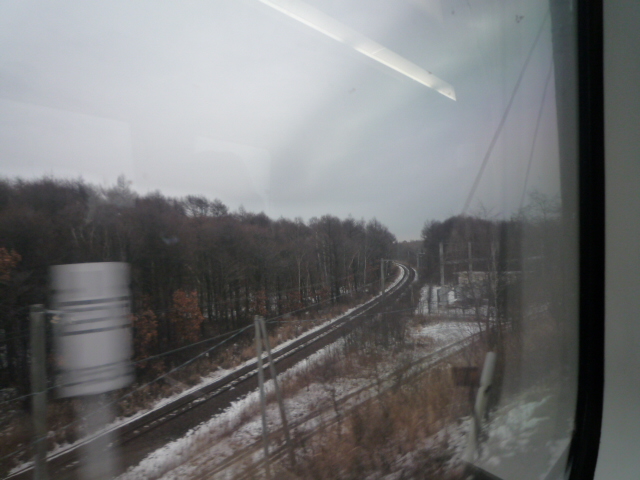 |
| The JR Sekisho Line track leading to Shintoku, Obihiro, and Kushiro |
 |
| New Chitose Airport, as seen from the JR Chitose Line between Minami-Chitose and Tomakomai |
 |
| A rice paddy field partly covered in snow |
 |
| A rice paddy field on a cloudy winter's day |
 |
| Passing by a forest on the JR Chitose Line |
 |
| The JR Hidaka Line tracks near Tomakomai Station |
 |
| My box of almond chocolates purchased from the on-board trolley service |
 |
| The KiHa 281 series DMU Green Car (first class) cabin while approaching Tomakomai Station |
 |
| At Tomakomai Station |
 |
| Almost finishing my almond chocolates |
 |
| The miniature Christmas Tree by the conductor's room in the KiHa 281 series DMU |
 |
| Passing a road bridge over a river that flows into the Pacific Ocean |
キハ281系 特急スーパー北斗10号 函館行き 車窓から登別駅に到着
 |
| At Noboribetsu Station |
 |
| Passing by some houses in Noboribetsu |
 |
| Sparse vegetation between Noboribetsu and Muroran |
 |
| Crossing another railroad bridge over a river |
 |
| A view of my seat, 3D, between Noboribetsu and Higashi-muroran |
 |
| Several railway tracks near Higashi-muroran Station |
 |
| At Higashi-muroran Station |
 |
| Passing by a freight train yard shortly after leaving Higashi-muroran |
 |
| Passing by a vegetation field on the JR Muroran Main Line |
 |
| A view of the Pacific Ocean with several breakwaters, taken from the Limited Express "Super Hokuto" No. 10 bound for Hakodate on the JR Muroran Main Line |
 |
| Passing by another vegetation field on the JR Muroran Main Line |
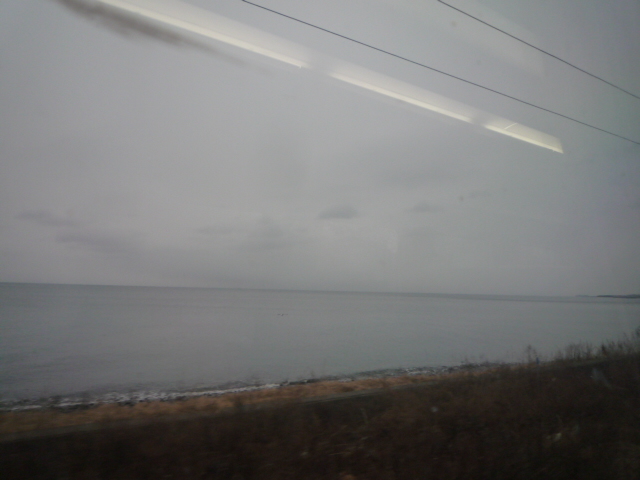 |
| A coast line on the Pacific Ocean by the JR Muroran Main Line |
 |
| A view of the Pacific Ocean, taken from the Limited Express "Super Hokuto" No. 10 bound for Hakodate on the JR Muroran Main Line |
 |
| At Date-mombetsu Station |
 |
| The KiHa 281 series DMU Green Car (first class) cabin while nearing Toya Station |
 |
| Passing Nagawa Station |
After a journey time of 1 hour 40 minutes from Sapporo, I finally arrived at Toya Station at 12.16 p.m., as planned. As soon as I alighted the train, I took a picture of it before it left for its remaining journey to Hakodate.
 |
| The KiHa 281 series DMU set, which took me to Toya from Sapporo earlier |
 |
| The name plate of Toya Station |
 |
| The station platform of Toya Station |
After I exited the station, I met my parents and younger brother at the car park outside the station. We then drove off to Shikotsu-Toya National Park to visit Lake Toya.
 |
| The station building of Toya Station |
 |
| The sign of Shikotsu-Toya National Park |
 |
| The map of Lake Toya |
 |
| Lake Toya with a ferry on the left hand side |
After we arrived at Lake Toya, we went to a nearby cafeteria and souvenir shop by the lake. There was a mini restaurant located in the upper floor. We had lunch at the restaurant before doing anything else.
 |
| The interior of the restaurant above the souvenir shop near Lake Toya |
 |
| A cup of chawanmushi and a mini basket of fried chicken |
 |
| Another view of the interior of the restaurant above the souvenir shop near Lake Toya |
 |
| And another view of the interior of the restaurant above the souvenir shop near Lake Toya |
 |
| A view of Lake Toya from the restaurant |
 |
| A view of Mount Usu from the restaurant near Lake Toya |
 |
| Outside the souvenir shop near Lake Toya after lunch |
 |
| A street in the town of Toyako |
 |
| A wet car parking area on a cloudy winter's day |
After having a relatively light lunch, we decided to take a ferry cruise around Lake Toya. As we reached the ferry ticket office, we purchased some tickets and were on board the ferry by 1.15 p.m.. The ride took approximately 1 hour 15 minutes.
 |
| A view of Lake Toya prior to boarding the ferry |
 |
| A view of the ferry just before boarding |
 |
| The interior of the lower deck of the ferry around Lake Toya |
 |
| Lake Toya from the ferry just before departure |
 |
| Another view of the interior of the lower deck of the ferry around Lake Toya |
 |
| A view of Lake Toya from the ferry just before departure |
 |
| A view of the boat jetty in Lake Toya from the ferry |
 |
| My mum and brother posing for a picture |
 |
| The mid-lake mountain as seen from the ferry in Lake Toya |
 |
| A view of a mountain in Toyako town as seen from Lake Toya |
 |
| Another view of a mountain in Toyako town as seen from Lake Toya |
 |
| A view of a mountain end in Toyako town as seen from Lake Toya |
 |
| Lake Toya during the cruise around the lake with the ferry |
 |
| A mountain in the middle of Lake Toya |
 |
| A packet of chocolate flavour koala biscuits |
 |
| A food and beverage counter in the upper deck of the ferry |
 |
| The town of Toyako as seen from the ferry in Lake Toya |
 |
| Another view of the town of Toyako as seen from the ferry in Lake Toya |
 |
| Lake Toya shortly before we arrived back at the jetty |
 |
| The staircase leading to the upper deck of the ferry in Lake Toya |
 |
| The ferry that takes tourists around Lake Toya |
After an enjoyable sightseeing ferry cruise around Lake Toya, we finally arrived back at the jetty at 2.30 p.m.. We then went to a small hot spring (onsen) by the lake. This onsen is used to warm the feet of other people in the cold winter season.
We then went back to the cafe inside the souvenir shop to have something light. I then had a small chocolate cake for myself.
 |
| Several boats on the jetty in Lake Toya |
 |
| The foot hot spring named Toro no Yu |
 |
| Inside the foot hot spring named Toro no Yu |
 |
| A view of the jetty beside Lake Toya |
 |
| A path along the lake |
 |
| Another view of the jetty beside Lake Toya |
 |
| Calligraphy signs of Lake Toya written on a stone |
 |
| The interior of the shop and cafeteria by the lake |
 |
| A small chocolate cake for myself |
It was about 3.30 p.m. by the time we finished. With that, I decided to head back to Toya Station for my train back to Sapporo. My family obliged to send me to the station. We then got into the car and drove to the station.
By 4 o' clock, I was back at Toya Station for my train back to Sapporo. According to my time schedule, I was to take the Limited Express Super Hokuto No. 13 bound for Sapporo from Toya. The train would leave Toya Station at 4.52 p.m.. Here are some pictures I took in the station while waiting for the Limited Express Super Hokuto No. 13 bound for Sapporo.
 |
| The station concourse of Toya Station |
 |
| The train departure information screens at the entrance to the station platforms of Toya Station |
 |
| The Green Car (first class) information in Toya Station |
 |
| On the platform towards Hakodate |
 |
| On the inter-platform footbridge of Toya Station |
 |
| On the platform for my train to Sapporo |
 |
| The name plate of Toya Station |
 |
| The station platform of Toya Station towards Higashi-muroran and Sapporo during nightfall |
 |
| A KiHa 283 series DMU trainset, operating on the Limited Express "Super Hokuto" No. 16 bound for Hakodate from Sapporo at Toya Station |
 |
| The information of Lake Toya on the station platform of Toya Station |
 |
| Another view of the name plate at Toya Station |
After approximately 45 minutes of waiting, the Limited Express Super Hokuto No. 13 bound for Sapporo finally arrived at Toya Station at 4.51 p.m.. I immediately boarded the Green Car (first class) cabin of the train, and settled into my assigned seat No. 6A for the journey back to Sapporo. At exactly 4.52 p.m., the train pulled out of Toya Station.
When the conductor came to check my ticket, I was surprised that she could speak English. She then brought me an antiseptic hand wipe and a cup of orange juice. Here are some pictures during the journey between Toya and Sapporo.
 |
| The KiHa 281 series DMU Green Car (first class) cabin shortly after leaving Toya Station |
 |
| A view of my seat, 6A, shortly after leaving Toya Station |
 |
| A single KiHa 281 series DMU Green Car (first class) seat shortly after leaving Toya Station |
 |
| My train ticket for the sector between Toya and Sapporo |
 |
| A view of the Green Car (first class) cabin of the KiHa 281 series DMU taken from my seat |
 |
| An antiseptic hand wipe and a cup of orange juice for myself |
 |
| The rear view of the KiHa 281 series DMU Green Car (first class) cabin shortly after leaving Toya Station |
 |
| The miniature Christmas Tree on the KiHa 281 series DMU back to Sapporo |
 |
| The front view of the KiHa 281 series DMU Green Car (first class) cabin while approaching Higashi-muroran Station |
 |
| Nearing Higashi-muroran Station |
キハ281系 特急スーパー北斗13号 札幌行き 東室蘭駅から発車とグリーン車
 |
| The KiHa 281 series DMU Green Car (first class) cabin from my seat shortly after leaving Higashi-muroran Station |
 |
| Passing through the city of Noboribetsu at night |
 |
| A view of my seat, 6A, during approach to Tomakomai |
 |
| A shopping mall near Tomakomai Station |
 |
| At Tomakomai Station |
 |
| Passing by the shopping mall car park |
 |
| The KiHa 281 series DMU Green Car (first class) cabin from my seat while approaching Minami-chitose Station |
キハ281系 特急スーパー北斗13号 札幌行き 車窓から南千歳駅に到着
 |
| The front view of the KiHa 281 series DMU Green Car (first class) cabin shortly after leaving Minami-chitose Station |
 |
| On the JR Chitose Line railroad bridge shortly after leaving Minami-chitose Station |
 |
| Passing through Chitose Station |
 |
| The rear view of the KiHa 281 series DMU Green Car (first class) cabin on the JR Chitose Line |
 |
| Passing by several houses in Chitose |
 |
| Passing by a field in Atsubetsu-ku, Sapporo |
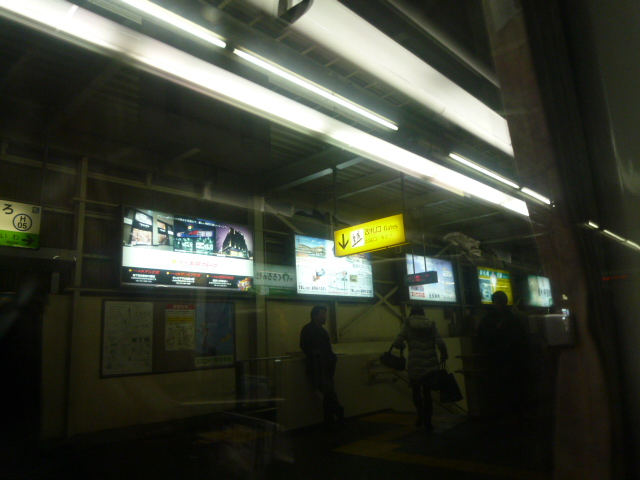 |
| At Shin-sapporo Station |
 |
| Shortly after leaving Shin-sapporo Station |
 |
| Passing by some housing areas in Shiroishi-ku, Sapporo |
 |
| Approaching the Sapporo terminal station |
After travelling from Toya for approximately 1 hour 43 minutes, I finally arrived at Sapporo Station at 6.35 p.m. on Track No. 4. I had approximately 10 minutes before my next train back to Otaru-chikko. The train that I was to take between Sapporo and Otaru-chikko would be the Rapid Airport No. 181 bound for Otaru. The train would leave Sapporo at 6.44 p.m. from Track No. 3, which was just adjacent to Track No. 4. Here are some pictures I took while waiting for the train.
 |
| The KiHa 281 series DMU Green Car (first class) cabin after arrival at the Sapporo terminal station |
 |
| The Green Car logo on the KiHa 281 series DMU |
 |
| The logo of the KiHa 281 series DMU at Sapporo |
 |
| The KiHa 281 series DMU train that took me back to Sapporo earlier |
 |
| The busy station platforms of Sapporo Station in the early evening hours |
After approximately 5 minutes of waiting, the Rapid Airport train No. 181 bound for Otaru finally entered Sapporo Station at 6.40 p.m. on Track No. 3. Immediately, I boarded the reserved seat ("u" seat) carriage, and settled into my assigned seat No. 3A for the journey. The journey between Sapporo and Otaru-chikko would take 26 minutes.
At exactly 6.44 p.m., the train pulled out of Sapporo Station for a 33-minute journey to Otaru. Here are some pictures and a video on the final sector between Sapporo and Otaru-chikko.
 |
| The reserved seat ("u" seat) logo on the 721 series EMU |
 |
| The rear view of the reserved seat ("u" seat) interior of the Rapid "Airport" train No. 181 bound for Otaru |
721系 快速エアポート181号 小樽行き 札幌駅から発車とuシート
 |
| My train ticket for the final sector between Otaru-chikko and Sapporo |
 |
| A view of my seat, 3A, during the journey back to Otaru |
 |
| At Kotoni Station |
After a journey time of 26 minutes from Sapporo, I finally arrived back at my terminal station, Otaru-chikko, at 7.10 p.m.. I walked out of the station and passed through Wing Bay Otaru to get back to the Grand Park Hotel Otaru.
My family and I all had a good rest in the hotel room. At around 10.30 p.m., we decided to go to Victoria Station for a late dinner. After arriving at Victoria's at 10.50 p.m., we asked for a table for the four of us. We had some mixed grills and sides while there during dinner.
 |
| Outside Victoria Station at night |
 |
| The special menus at Victoria's |
 |
| Inside the restaurant |
 |
| The Grand Menu at Victoria Station |
 |
| The night scenery of Otaru from the restaurant |
 |
| The special recommendation menu |
 |
| My usual mixed grill on a hot plate |
 |
| The interior of Victoria Station Otaru at night |
 |
| Another view of the interior of Victoria Station Otaru |
 |
| The car park outside the restaurant at night |
It was already 11.20 p.m. by the time we finished our dinner. After we paid our bill, we drove back to the Grand Park Hotel Otaru. Once we reached the hotel room, I had a lovely, hot shower before doing anything else. We all went to bed just before 2 in the morning.
Very well, folks, this brings the third section of my winter holiday in Hokkaido, Japan in December 2010 to a conclusion. The remaining parts will be published as soon as there's time.









0 件のコメント:
コメントを投稿